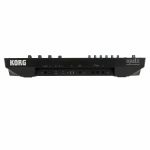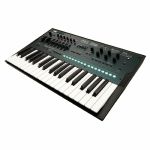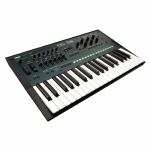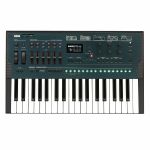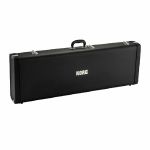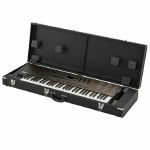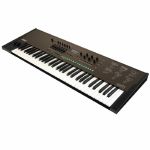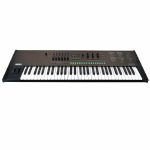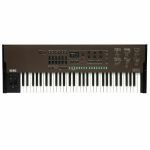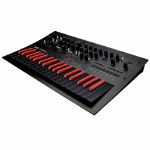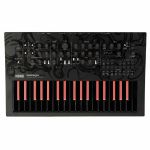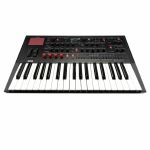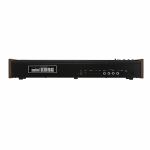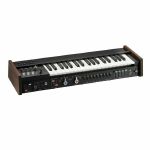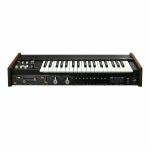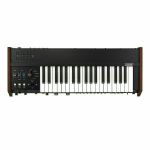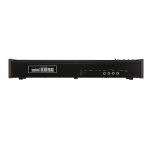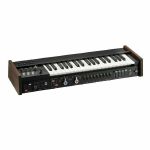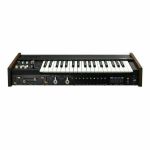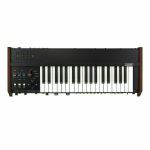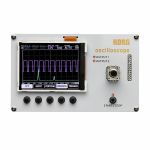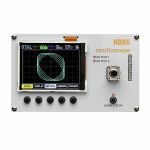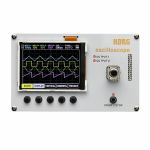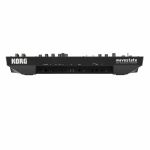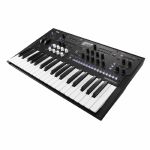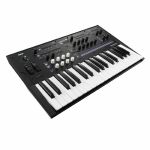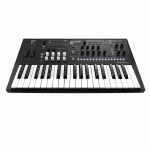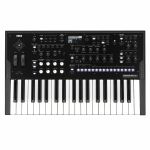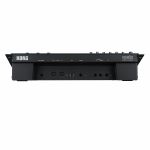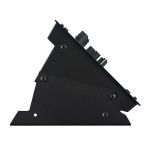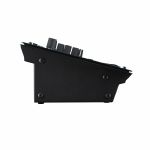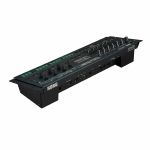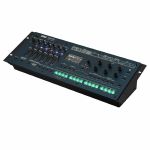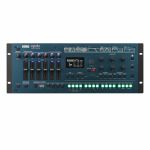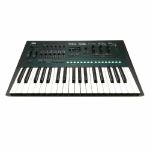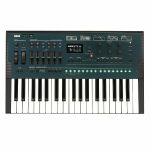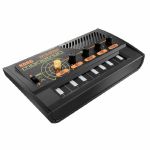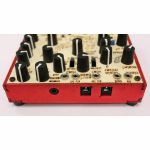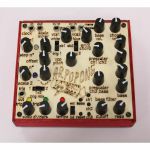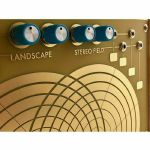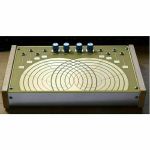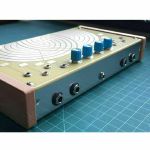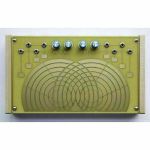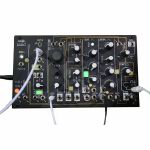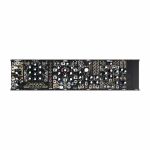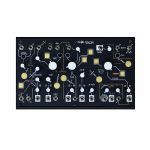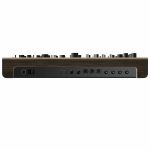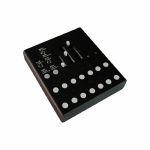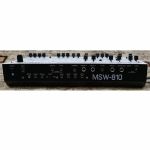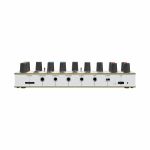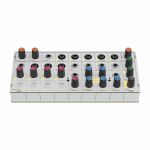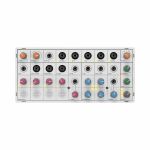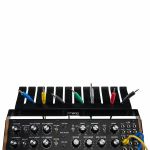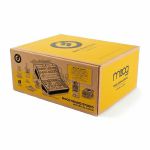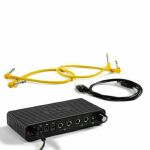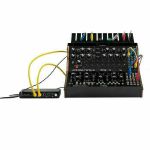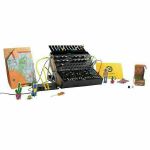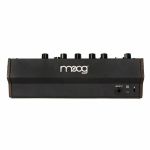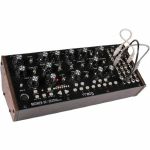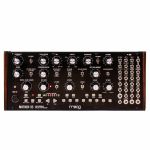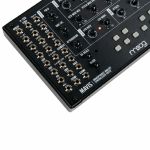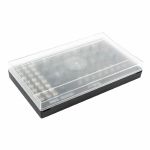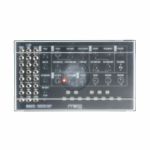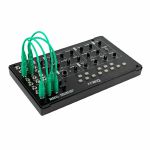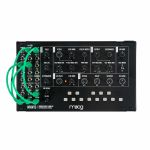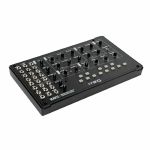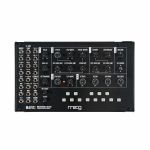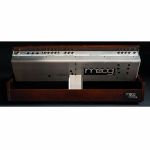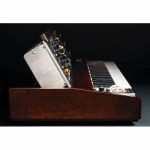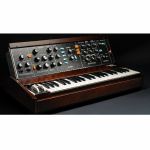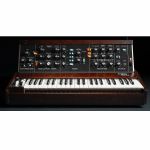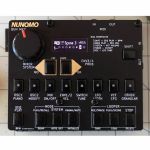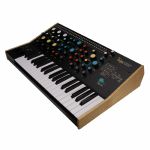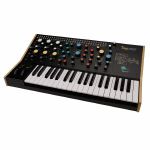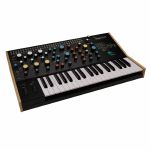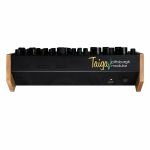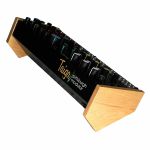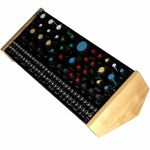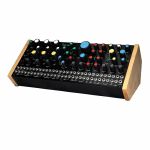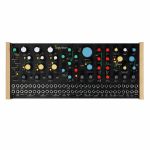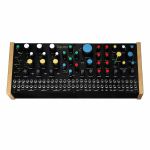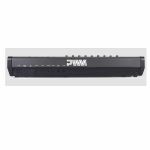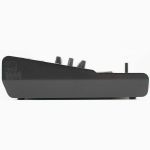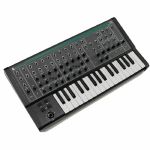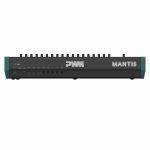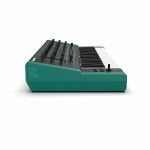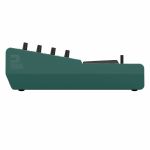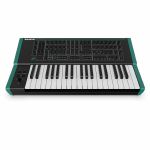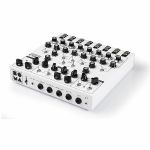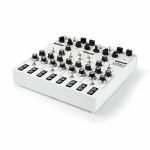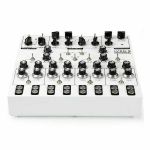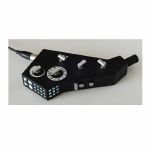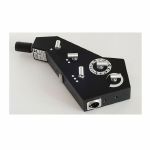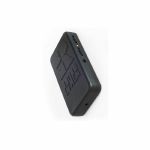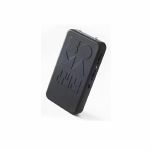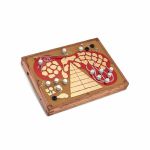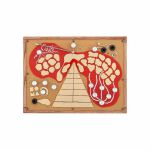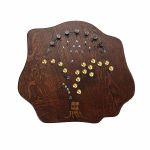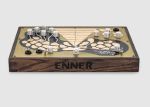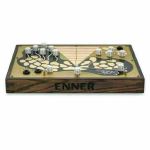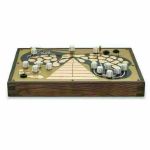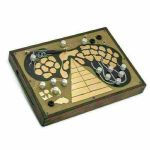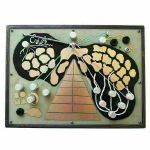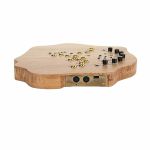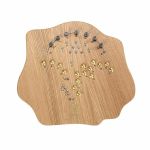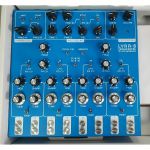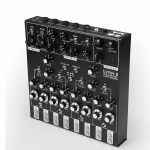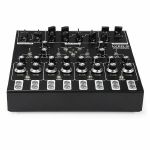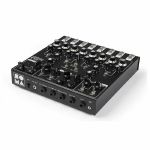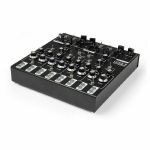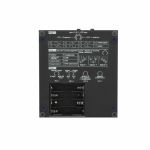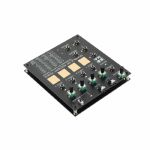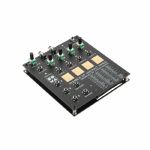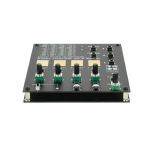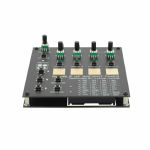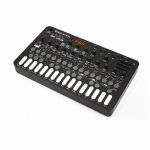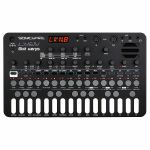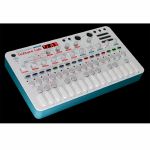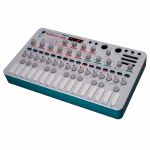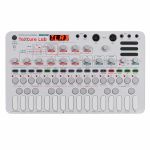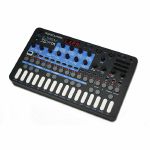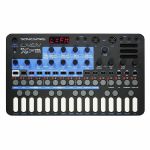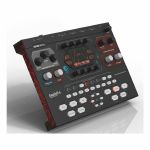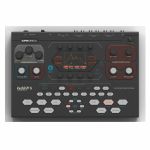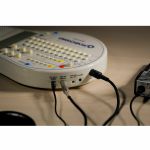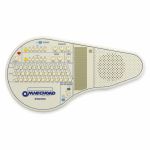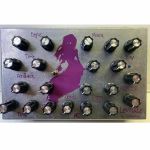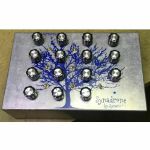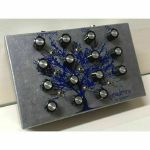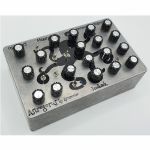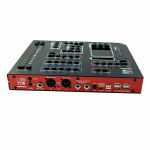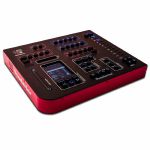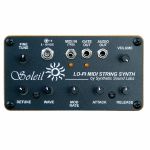Studio equipment
Our full range of studio equipment from all the leading equipment and software brands. Guaranteed fast delivery and low prices.
DJ equipment
Our full range of DJ equipment from all the leading equipment and software brands. Guaranteed fast delivery and low prices. Visit Juno DJ
Filter
Stock
Coming Soon
Equipment
Format
Release Date
Price
Tags
Supplier's Notes:
A Full-Spectrum Sound Experience
Opsix mk II is a digital synth like no other. Based on the sound engine of the original Opsix, the number of simultaneous voices and voicings has been expanded to an astounding 64 voices. The result is superior performance and precise control.
The Opsix Operator Mixer simplified FM synthesis for the first time, making it not just comprehensible but also controllable. With the addition of extra synthesis capabilities and programming, it offered a more efficient workflow and an even richer sound.
And, it is fully compatible with the sounds and samples from both the original opsix and the opsix Native software, including numerous high-quality libraries.
Evolved to an astounding 64 voices
The Opsix mk II has 64 voices, twice as many as the original 32 voices, allowing users to enjoy tone editing without having to worry about the number of simultaneous voices. In addition, the operator-mixer section, the most distinctive feature of this product, has been accented with a new image colour, green.
Get Illuminated with the Operator Mixer
At the heart of every sound is Opsix mk II's Operator Mixer - a simple set of six faders and knobs that invite exploration. Each part lights up red to indicate carriers or blue for modulators. Manipulating them opens up new sound-shaping possibilities to breathe fresh life into your musical ideas. This straightforward, hands-on workflow is part of what makes Opsix mk II so unique, just like the sounds it offers.
Direct Hands-On Control
Whether you're tweaking a preset or building a patch from the ground up, the six data entry knobs on the right give you quick access to the parameters you need and seamlessly sync with the large OLED display, giving you a clear, focused direction to your workflow. Coupled with the mixer, it makes creating fresh sounds super easy and, most importantly, fun!
Select from a full range of analogue-style filters, from the radical Korg MS-20 low-pass/high-pass filter to the powerful yet smooth KORG Polysix low-pass filter that gives your sound a vintage feel. There are also two or four-pole low-pass, high-pass, band-pass, and band-reject filters with resonance.
There's even a built-in spectrum analyser and oscilloscope that gives you visual feedback via the screen on the music you're making.
Six in One Synthesis
The core of Opsix mk II is nothing short of exponential. Since waveforms can be arranged and modulated in nearly infinite ways, Opsix mk II can easily do the sonic work that is similar to numerous types of synthesis:
Subtractive
Removing parts of the sound to get the sound you want; the most widely-used synthesis. Opsix mk II uses up to six envelopes and multi-modelled filters to achieve many cutting-edge and classical analogue synthesis tones.
Semi-Modular
Rerouting signal paths to change the sound. A spin through the Algorithm section will dramatically reshape the sound by changing how the signal routing between the operators work together, and no patch cables are needed. Analog-style controls and plenty of stackable waveforms take you from digital to analogue-sounding in no time. Enjoy deep basses, crisp leads, thick pad sounds, fuzzy brass tones, and so much more.
Analogue (Modeling)
Analogue-style controls and plenty of stackable waveforms take you from digital to analogue-sounding in no time. Enjoy deep basses, crisp leads, thick pad sounds, fuzzy brass tones, and so much more.
Waveshaping
Adding intentional distortion to the waveforms to achieve aggressive overtones that are either harmonic or inharmonic. This will help you achieve gritty, bitey tones dripping with character.
Additive
Stacking waveforms and blending their harmonics is key to an expansive range of harmonious, dissonant, and tension-driven sounds. With six operators available, the complete FM experience is possible, including the ability to go back in time for classic sounds you have heard throughout recording history.
Classic FM
Last but certainly not least, Opsix's highly flexible and powerful architecture starts with true six-Operator FM. As a result, it easily delivers signature sounds you have surely heard on thousands of hits from the '80s on through today, and with far more polyphony than other standalone FM synths available today.
With all of these ways to realize and explore sounds, Opsix mk II is uniquely suited as a "future-modern-classic" synth!
Altered Reality
What started as a legacy synthesis has evolved into something completely different. Opsix mk II is FM-based, but the similarities to the classic synthesis end there. The Altered FM architecture delivers sounds across a vast spectrum, far wider than any single synthesis has been able to cover before, thanks to new sound components; new waveforms, filters, shaping, effects, LFOs, envelopes, modulations, and more, all translating to its broad assortment of sounds.
Powerful Effects Processing
Opsix mk II provides three blocks of 30 types of high-definition effects that you can use together to enhance your sounds even further. There's everything from a great mix of usable standard effects like chorus, phaser, delay, and compressor to some world-class shimmering reverbs that will elevate your sound to the next level.
Specifications
Keyboard: 37 keys (velocity and release-velocity sensitive)
Sound generating system: Altered FM sound generator
Maximum Polyphony: 64 voices (varies depending on the setting)
Structure: 6 operators, 1 filter, 3 EGs, 3 LFOs, 3 effects, step sequencer, arpeggiator
Algorithm: 40 presets + user algorithm (unique to each program)
Operator: 6 modes (FM, Ring Mod., Filter, Filter FM, Wave Folder, Effect)
Oscillator waveform: 23 waveforms (Sine, Sine 12bit, Sine 8bit, Triangle, Saw, Saw HD, Square, Square HD, Additive Saw3, Additive Sqr3, Additive Tri3, Additive 12345, Additive 1+2, Additive 1+3, Additive 1+4, Additive 1+5, Additive 1+6, Additive 1+7, Additive 1+8, Noise S/H, Noise White, Noise Pink, Noise Blue)
Filter: 11 types (LPF 12, LPF 24, LPF MS-20, LPF POLY6, HPF 12, HPF 24, HPF MS-20, BPF 6, BPF 12, BRF 6, BRF 12)
EG: ADSR
LFO: 23 waveforms (Triangle, Saw Down, Saw Up, Square, Sine, Sample&Hold, Guitar, Exp. Triangle, Exp. Saw Down, Exp. Saw Up, Step4 Triangle, Step6 Triangle, Step4 Saw Down, Step6 Saw Down, StepRnd:Time, StepRnd:Lvl&Time, StepRnd:Level, Random:Time, Random:Lvl&Time, Triangle + , Saw Down + , Saw Up + , Square +)
V.Patch: 12 routings
Effect: 30 types (Chorus, Unison Ensemble, Phaser, Phaser (BPM) , Auto Pan, Auto Pan (BPM), Flanger, Flanger (BPM) , Rotary Speaker, Auto Wah, Exciter, Enhancer, LFO Filter, 3-Band EQ, Distortion, Guitar Amp, Decimator, Grain Shifter, Master Limiter, Compressor, Delay, Delay (BPM) , Autopan Dly, Autopan Dly (BPM), Tape Echo, Tape Echo (BPM) , Early Reflection, Reverb, Shimmer Reverb, Spring Reverb)
Sequencer: Step Sequencer (up to 16 steps, up to 6 notes per step), Motion Sequencer (up to 6 lanes)
Arpeggiator: 7 patterns (MANUAL, UP, DOWN, ALT1, ALT2, RANDOM, TRIGGER)
Number of programs: 500 (350 preset programs and 150 user programs as the factory-set default)
Favourite: 64 (16 Slots × 4 Banks)
Controllers: MODULATION wheel, PITCH wheel, RATIO OP 1-6 knobs, LEVEL OP 1-6 sliders, DATA ENTRY A-F knobs
Inputs/outputs: Headphone (6.3 mm stereo phone jack), OUTPUT L/MONO and R (impedance-balanced 6.3 mm TRS phone jacks), DAMPER (6.3 mm phone jack, half-damper not supported), MIDI IN and OUT connectors, USB B port
Power supply: AC adapter (DC12V)
Power consumption: 5 W
Dimensions (W × D × H): 565 × 338 × 90 mm / 22.24" × 13.31" × 3.54"
Weight: 2.9 kg / 6.93 lbs.
Included items: AC adapter
Accessories (sold separately): DS-1H damper pedal, PS-1 pedal switch, PS-3 pedal switch
quote 995087
Premium version of the excellent Opsix, Korg's contemporary take on FM synthesis. Full 61-note natural-touch keybed with aftertouch, 80-voice stereo polyphony and full metal construction.
Supplier's Notes:
The Ultimate Union of Power and Performance
opsix SE is a digital synth like no other. With a premium all-metal design, 61-keys, and aftertouch, it unlocks a new world of sonic capabilities. Building on the expansive sound engine in the original opsix, opsix SE enhances it with increased polyphony and voicing, resulting in a synthesizer created for superior performance and precise control.
The opsix Operator Mixer simplified FM synthesis for the first time, making it not just comprehensible but also controllable. With the addition of extra synthesis capabilities and programming, it offered a more efficient workflow and an even richer sound.
The opsix SE takes this even further. It is equipped with Korg's premium 61-key natural-touch keyboard, complete with aftertouch, delivering the exceptional tactile experience expected from Korg's flagship workstations. With a sleek, robust metal body, it's built for both the intensity of live gigs and the precision of studio sessions. The metallic knobs are optimally weighted for effortless adjustments. Underneath its exterior, the opsix SE boasts an incredible capacity of 80 stereo voices of polyphony.
The opsix SE arrives preloaded with hundreds of sounds enhanced for aftertouch control. Moreover, it is fully compatible with the sounds and samples from both the original opsix and the opsix Native software, including numerous high-quality libraries.
Build to play
opsix SE was born out of the desire to play this incredible synth with both hands. Equipped with KORG's premium 61-note natural-touch keyboard, the opsix SE offers the same outstanding tactile response as KORG's top-tier workstations. Aftertouch puts unparalleled control of all the exceptional opsix sounds at your fingertips. Of course, we've modernized the factory Performances for aftertouch and introduced some fresh ones to the mix as well. In fact, most of the opsix SE programs have been revised to make full use of aftertouch, extended keyboard, and polyphony.
Premium metal design
The opsix SE showcases a notable upgrade in aesthetics. A slim body, specifically designed for this instrument, features a striking brown painted aluminium control panel, paying homage to vintage machines. Together with the vivid, illuminating LEDs, it brings a vibrant energy to any stage performance. The side panels, painted in a sleek black metal, amplify the overall aesthetics for a luxurious finish.
Exclusive hard case included
The opsix SE ships in a dedicated hard case, including space for cables and a sustain pedal. Your instrument can travel protected, whether you're carrying it to a rehearsal downtown or packing it up for a tour.
Get Illuminated with the Operator Mixer
At the heart of every sound is opsix SE's Operator Mixer - a simple set of six faders and knobs that invite exploration. Each part lights up red to indicate carriers or blue for modulators. Manipulating them opens up new sound-shaping possibilities to breathe fresh life into your musical ideas. This straightforward, hands-on workflow is part of what makes opsix SE so unique, just like the sounds it offers.
Direct Hands-On Control
Whether you're tweaking a preset or building a patch from the ground up, the six data entry knobs on the right give you quick access to the parameters you need and seamlessly sync with the large OLED display, giving you a clear, focused direction to your workflow. Coupled with the mixer, it makes creating fresh sounds super easy and, most importantly, fun!
Select from a full range of analogue-style filters, from the radical Korg MS-20 low-pass/high-pass filter to the powerful yet smooth KORG Polysix low-pass filter that gives your sound a vintage feel. There are also two or four-pole low-pass, high-pass, band-pass, and band-reject filters with resonance.
There's even a built-in spectrum analyser and oscilloscope that gives you visual feedback via the screen on the music you're making.
Six in One Synthesis
The core of opsix is nothing short of exponential. Since waveforms can be arranged and modulated in nearly infinite ways, opsix can easily do the sonic work that is similar to numerous types of synthesis:
Subtractive
Removing parts of the sound to get the sound you want; the most widely-used synthesis. opsix uses up to six envelopes and multi-modeled filters to achieve many cutting-edge and classical analog synthesis tones.
Semi-Modular
Rerouting signal paths to change the sound. A spin through the Alogorithm section will dramatically reshape the sound by changing how the signal routing between the operators work together, and no patch cables are needed.
Analog (Modelling)
Analog-style controls and plenty of stackable waveforms take you from digital to analogue-sounding in no time. Enjoy deep basses, crisp leads, thick pad sounds, fuzzy brass tones, and so much more.
Waveshaping
Adding intentional distortion to the waveforms to achieve aggressive overtones that are either harmonic or inharmonic. This will help you achieve gritty, bitey tones dripping with character.
Additive
Stacking waveforms and blending their harmonics is key to an expansive range of harmonious, dissonant, and tension-driven sounds. With six operators available, the complete FM experience is possible, including the ability to go back in time for classic sounds you have heard throughout recording history.
Classic FM
Last but certainly not least, opsix's highly flexible and powerful architecture starts with true six-Operator FM. As a result, it easily delivers signature sounds you have surely heard on thousands of hits from the '80s on through today, and with far more polyphony than other standalone FM synths available today.
With all of these ways to realize and explore sounds, opsix SE is uniquely suited as a "future-modern-classic" synth!
Altered Reality
opsix SE is FM-based, but the similarities to the classic synthesis end there. The Altered FM architecture delivers sounds across a vast spectrum, far wider than any single synthesis has been able to cover before, thanks to new sound components; new waveforms, filters, shaping, effects, LFOs, envelopes, modulations, and more, all translating to its broad assortment of sounds.
Powerful Effects Processing
opsix SE provides three blocks of 30 types of high-definition effects that you can use together to enhance your sounds even further. There's everything from a great mix of usable standard effects like chorus, phaser, delay, and compressor to some world-class shimmering reverbs that will elevate your sound to the next level.
Automatable 16-step sequencer
opsix SE features an incredible step sequencer that rivals groove boxes for flexibility and power. Press the PLAY button on any sound and experience the complexity of the sequences! Every Program has its unique sequence stored with it, or create your very own.
You can record up to six notes per step and edit each note's velocity, gate time, and playback timing. Create long phrases or make subtle shifts in timing to emulate strums or drum rolls, something that's not possible on a typical 16-step sequencer. The motion sequencer of the opsix SE also lets you record changes of up to six parameters, creating smooth motion changes in sound within a phrase or building rhythms that change dramatically with each step.
1 in stock $1,524.72
Supplier's Notes:
Minilogue Bass is the evolution of the iconic Korg Minilogue into an all-analogue bass powerhouse.
An expandable poly-synth that retains the hands-on control and immersive playability of the original, Minilogue Bass drops deep, dark, thunderous low-end for cutting production-ready bass.
Production-ready bass
Minilogue Bass includes patches optimized by professional bass and synth programmers, ready to drop into your track or performance. But that's just the beginning - everything can be customised- the analogue possibilities are virtually endless.
All 100 preset patches are exclusive to Minilogue Bass, and can be further expanded with an additional 100 user programs for a total of 200 slots.
Powerfully analogue
The thickness, presence, and immense sonic palette provided by Minilogue Bass is due to an all-analogue signal path. It has two VCOs, a VCF, two EGs, a VCA and an LFO, while retaining the hands on control and unique wave shaping through oscillator harmonics from Minilogue.
Minilogue Bass includes cross modulation, oscillator sync, and a ring modulator, alongside a high pass filter delay to further expand your sound creation possibilities.
Eight voice modes
Minilogue Bass is a four-voice poly synth, with eight voice modes for broad versatility. Alongside POLY and CHORD modes, DUO stacks two voices in unison, UNISON works as a 4 part mono synth, MONO is monophonic but with a sub-oscillator playing an octave lower, DELAY plays 3 voices in sequence after the first, ARP is a 4 voice arpeggiator, and SIDE CHAIN lowers the volume of previously played notes.
16-step sequencing
Minilogue Bass offers powerful and intuitive sequencing possibilities. The 16-step polyphonic sequencer also captures the motion of up to four real-time controls, and can be overdubbed or step-sequenced, alongside the ability to change the root position of the playback by playing a key.
Overview
Sound visualisation
Minilogue Bass has an OLED oscilloscope that shows you the waveform as you sculpt your sound.
Sound librarian
The Minilogue Bass Sound Librarian allows for easy organisation of programs inside your synth, and can also save the entire library to a computer. It even gives the ability to load any existing Minilogue patches alongside factory and bonus libraries from Korg.
Solid looks
The sand-blasted 2mm aluminium front panel on Minilogue Bass features an edgy appearance, which is emphasised by the inverted black and red keys. A red-coloured wood rear panel further adds to a unique appearance.
Minilogue bass is also roadworthy - with metal shaft chassis-mounted potentiometers and rubber coated knobs complementing its powerful and dynamic sound creation possibilities.
In sync
Alongside MIDI and USB, Minilogue Bass has a sync connector for effortless connectivity with Volcas, Electribes and SQ-1 sequencer.
Specifications
Keyboard: 37-keys (Slim-key, velocity sensitive)
Sound Generation: Analog synthesis
Maximum Polyphony: 4 voices
Program
200 programs (100 Presets / 100 Users)
Each program includes voice mode and sequence data settings
Up to eight favorite programs can be registered
Voice Modes: 8 modes (Poly, Duo, Unison, Mono, Chord, Delay, Arp, Side Chain) -
VOICE MODE DEPTH can vary different parameters in each mode
Main Synthesis Parameter
VCO1: Octave, Wave (Saw, Triangle, Square), Pitch, Shape
VCO2: Octave, Wave (Saw, Triangle, Square), Pitch, Shape
VCO2 MODULATION: Cross Mod Depth, Pitch EG Int, Sync, Ring
MIXER: VCO1, VCO2, Noise
FILTER: Cutoff, Resonance, EG Int, Filter Type (2-Pole, 4-Pole), Keytrack, Velocity
AMP EG: Attack, Decay, Sustain, Release
EG: Attack, Decay, Sustain, Release
LFO: Wave (Saw, Triangle, Square), EG Mod (Int, Rate, Off), Rate, Int, Target (Pitch, Shape, Cutoff)
DELAY: Hi Pass Cutoff, Time, Feedback, Output Routing (Post Filter, Pre Filter, Bypass)
Sequencer
16-step polyphonic sequencer
Motion sequence can be used on up to four parameters
Controls
41 dedicated panel controls deliver immediate parameter access
A slider can control different parameters for each program
Display: Real-time OLED oscilloscope provides visual feedback of parameter changes
Connectors: Headphones (6.3mm stereo phone jack), Output (6.3mm monaural phone jack), Audio In (6.3mm monaural phone jack), Sync In (3.5mm monaural mini jack), Sync Out (3.5mm monaural mini jack), MIDI In, MIDI Out, USB Type B
Power Supply: AC adapter (DC9V)
Power Consumption: 8 W
Dimensions (W x D x H): 500 x 300 x 85 mm / 19.69" x 11.81" x 3.35"
Weight: 2.8 kg / 6.17 lbs.
Included Items: AC adapter
Supplier's Notes:
Modwave is a synthesis powerhouse with distinctive wavetable timbres, Kaoss Physics, and Motion Sequencing 2.0. The new Modwave mkII provides an astonishing 60 voices of polyphony almost double that of the original Modwave. All LFOs have been updated with options for free running, delayed start, and retriggering, and a pre/post switch for reverb sends has been added, alongside new modulation sources, and more.
Modern monster synth
In 1985, Korg introduced the DW-8000 - a synth which combined digital wavetables with rich analogue filters to give users sounds which were impossible to create with analogue oscillators.
Modwave builds on the DW legacy, transforming it into a modern monster synth, featuring incredibly deep wavetable oscillators, gorgeous filters, wildly flexible modulation, unmatched polyphony, comprehensive pattern sequencing, and immediately satisfying hands-on control to deliver unique, powerful, and easily customizable sounds and phrases.
Over 200 factory wavetables each contain up to 64 waveforms. 30+ Modifiers can be used to change their basic character, and 13 Morph Types to process them in real-time. Using the unique, realtime A/B Blend, it's possible to create new hybrids from any two wavetables.
Expanded possibilities
Modwave can be expanded by importing new wavetables using the free Editor/Librarian software. There are many free and commercial wavetable libraries in the standard Serum format, or you can create your own using the free, cross-platform WaveEdit software (available in a custom version for the Modwave). Wavetables can be layered with samples from the built-in, multi-gigabyte PCM library, or import your own 4 GB of samples using the Sample Builder software.
Each Program has two full-featured wavetable oscillators, plus a sub oscillator/noise generator and any of a dozen stereo filter types, including the aggressive MS-20, sweet Polysix, and the newly enhanced Multi Filter. Animate almost any parameter using the massively flexible modulation system, with four triggerable envelopes, five LFOs, dual mod processors and two key-track generators-plus multi-lane Motion Sequencing and Kaoss Physics.
Even with all that synthesis power, playing up to four simultaneous wavetables per voice in a single Program, the Modwave mkII achieves 60-voice polyphony, incredible for a wavetable synth. Layer two Programs together for double the possibilities.
KAOSS in motion
Modwave introduced two unique new tools for creating dynamic motion: Kaoss Physics and Motion Sequencing 2.0. KaossPhysics combines an x/y Kaoss pad with modulatable game physics to create a responsive, interactive controller that is extraordinarily powerful.
Motion Sequencing 2.0 brings the organic, continuously evolving patterns of the Wavestate Wave Sequencing 2.0 into the world of motion sequencing, including multiple lanes and real-time recording to help you create complex and evolving phrases that other step sequencers cannot.
Modwave's evolved wavetable synthesis delivers its own brand of completely unique sounds and a knob-per-function layout that makes customizing those sounds fast and easy. There are hundreds of preset sounds empowered by this new architecture, organised by front-panel category buttons, and all instantly customizable via the four Mod Knobs. Modwave'sdistinctive wavetable timbres start with aggressive basses & leads, and lush ambient pads which will add a new dimension to your tracks. But that is just the beginning.
Those who want to dig deeper will find an endless source of discovery; with the Modwave's unique synth architecture, you'll be finding new things for a long, long time. Save as many of your sounds as you like; there's room for thousands more. You can also load your own samples, import wavetables in standard formats, and create your own wavetables using the free WaveEditsoftware.
KAOSS Physics
Kaoss Physics models a ball rolling on a surface and bouncing off walls. The surface can tilt in any direction, and a bump with variable height/depth and location attracts or repels the ball. Adjustable friction slows the ball's travel, and adjustable time controls the speed of the entire model. All of these characteristics are modulatable, so you can change them in real-time!
Start the ball by flicking a finger on the x/y pad, or launch the ball automatically using another modulation source. You can even directly control the ball by holding your finger on the pad. The position of the ball produces eight modulation signals, which can be used to control any modulation destination: the X and Y locations, the distance from the centre, the angle relative to the X axis, and separate signals for +/- X and +/- Y.
Walls can slow down the ball, as if they were padded, or accelerate the ball, like bumpers in a pinball machine. The walls can also be removed entirely, so that the surface wraps around to the opposite edges like a vintage arcade game.
The modelled environment can create specific modulation effects. For instance, use a centered bump with negative height so that the modulation values always eventually return to 0. Or, position a bump with positive height on a side or a corner, to push modulation values away from that zone.
The result is an interactive controller that amplifies your physical gestures, transforming them into complex musical results.
Motion Sequencing 2.0
Motion Sequencing 2.0 is evolved from the Wavestate's Wave Sequencing 2.0. Timing, Pitch, Shape, and four sets of Step Sequence values are separated into "Lanes," each with their own loop start and loop end, adding a deeper, more customizable level of phrase and modulation recording.
Every time the sequence moves forward, the individual Lanes are combined to create the output. For instance, a step sequence value may be matched with a different duration, pitch, and shape every time that it plays. You can modulate each Lane's loop points separately for every note, using velocity, LFOs, envelopes, Mod Knobs, or other controllers. Each note in a chord can be playing something different!
Lanes can also randomize the step order every time they play. Finally, individual steps can be randomly skipped, with a modulatable probability from 0 to 100%. The result is organic, ever-changing sounds that respond to your control. The dual onboard arpeggiators can interact with Motion Sequences for even more possibilities.
Wavetables
Wavetables are sets of single-cycle digital waveforms, arranged in a specific order. The wavetable's "position" determines which waveform is played. Moving the position with an envelope, LFO, or other modulation source creates subtle or dramatic changes in timbre. Some wavetable systems switch abruptly from one waveform to another; others crossfade smoothly between them. Modwave can do either one.
Modifers
Use over 30 Modifiers to alter the character of any wavetable at load time. For instance, isolate the odd or even harmonics, add weight through anti-aliased quantization or saturation, or revisit the gritty character of old-school wavetable synths with the Vintage 8 & 12 options.
Morph
The 13 Morph Types let you stretch, squeeze, reflect, and otherwise alter the wavetables in real-time, changing their timbre andiwhen modulatedicreating additional motion in the sound. Sync creates classic swept-sync timbres, using only a single oscillator. Three special Morph TypesiFM, AM, and Ring Modimodulate Osc 2 with Osc 1, and the last two even apply to samples.
A/B Blend
Using the unique A/B mode, oscillators can blend any two wavetables with phase-synchronous precisionidifferent from simply layering voicesiopening up a dimension of intermediate waveforms. Add body to otherwise "thin" waveforms, for instance, or a touch of sizzle to a mellow timbre. Even fade between two different "modifier" versions of the same wavetable. A/B Blend can be modulated in real-time, of course.
Or, step outside the box with Korg's unique Multi Filter, which creates modulatable blends of multiple modes simultaneously - now with presets on a front panel knob, for easier exploration of its many possibilities.
An arsenal of effects
Modwave's superb effects deliver production-ready sounds. Each Layer has three dedicated effects, plus a send to the Performance's master reverb, followed by a master parametric EQ. Along with standards such as compressors, EQs, choruses, flangers, phasers, and stereo delays, you'll find distinctive processors such as the Wave Shaper, Talking Modulator, Reverse Delay, Multiband Mod Delay, and Overb (from the OASYS and Kronos), plus modeled effects including VOX guitar amps, VOX wah, multi-head tape echo, and a collection of classic guitar pedals.
1 in stock $617.77
quote 978249
Supplier's Notes:
Back To The Future: a limited edition authentic revival of the miniKORG 700.
The miniKORG 700 was KORG's first mass-produced monophonic synthesizer released in 1973 at a time when the form of synthesizers as musical instruments had not been fully established. After a lot of experimentation, the miniKORG 700 arrived bringing the world of synthesizers to a wide group of users by offering simple operations that could producing extreme changes in sound, and was championed by a strong base of admiring musicians.
The miniKORG 700FS is an authentic revival of the miniKORG 700S, (an improved version of the miniKORG 700) that was released the following year. The revised miniKORG 700FS offers added functionality such as an arpeggiator, spring reverb and aftertouch. The miniKORG 700FS is a fully-realized analog synthesizer that was developed in conjunction with the original designer, Fumio Mieda.
(Note: To avoid confusion in the following text, both the original miniKORG 700 and the miniKORG 700S are listed as "miniKORG 700" for the most part.)
Why revive the miniKORG 700 now?
The real beauty and awesomeness of the sounds produced by the miniKORG 700 could not be realized through analog modeling technology that uses computational integrated circuitry such as DSPs and other devices to model analog circuitry. And although KORG continues to produce analog synthesizers such as the prologue, the minilogue and many others, we recognize that these instruments owe their existence to the miniKORG 700.
While theoretical know how is important when designing analog circuitry, deep experience is also required to understand what the results will actually be once the circuitry is completed. Ten years have passed since the monotron, a next-generation analog product from 2010 was developed by young KORG engineers and analog enthusiasts. It took some time for the full vision of these engineers to be explored and delivered but at last we've finally arrived - at the start.
KORG's wish is for customers to experience the beauty and awesomeness of the authentic analog sound through the miniKORG 700FS designed by the KORG analog engineers under the supervision of Fumio Mieda, who designed the original circuitry, ensuring that the elements that go beyond the circuit schematics would be faithfully represented.
While the miniKORG 700 was KORG's first synthesizer, it also produced some of the fattest and most dense sounds of all of our synthesizers. The miniKORG 700FS, features oscillators with a penetrating sound and an authentic recreation of the Traveler controller, one of the key features of the miniKORG 700.
The volca keys and volca bass use the filter circuit from the miniKORG 700, because the clear and penetrating characteristics of this filter were a perfect match for products that specialize in lead and bass synth sounds with a strong presence. The miniKORG 700 sound sits easily in today's music, particularly with its lead and bass synth sounds.
The miniKORG 700 came about as a sub keyboard that players would set atop their organs (frequently used in the 1970s) to augment the organ's sound palette. Nowadays, the beautiful lead synth sound of the miniKORG 700FS works well with stage keyboards such as or electric pianos, organs and so on.
The controls on the miniKORG 700 were laid out below its keys in a row, so that players who set the instrument on top of their organ would find them easy to access. Even today, this layout is intuitive and easy to understand, with a unique look that no other instrument offers.
When the miniKORG 700 was originally released, electronic components were larger in size, limiting its functionality due to the small space inside. Thanks to changes in technology, there's now have more space to add a spring reverb effect as well as a joystick for pitch bend and modulation. The new version also features aftertouch for added expressiveness, as well as important features an arpeggiator, USB port, MIDI IN connector and a CV/GATE IN jack.
Dimensions (W x D x H): 744 x 280 x 122 mm/29.29" x 11.02" x 4.80"
Weight: 8.5 kg/18.74 lbs.
Power supply: AC adapter (DC 12V)
Power consumption: 9W
Supplier's Notes:
Back To The Future: a limited edition authentic revival of the miniKORG 700.
The miniKORG 700 was KORG's first mass-produced monophonic synthesizer released in 1973 at a time when the form of synthesizers as musical instruments had not been fully established. After a lot of experimentation, the miniKORG 700 arrived bringing the world of synthesizers to a wide group of users by offering simple operations that could producing extreme changes in sound, and was championed by a strong base of admiring musicians.
The miniKORG 700FS is an authentic revival of the miniKORG 700S, (an improved version of the miniKORG 700) that was released the following year. The revised miniKORG 700FS offers added functionality such as an arpeggiator, spring reverb and aftertouch. The miniKORG 700FS is a fully-realized analog synthesizer that was developed in conjunction with the original designer, Fumio Mieda.
(Note: To avoid confusion in the following text, both the original miniKORG 700 and the miniKORG 700S are listed as "miniKORG 700" for the most part.)
Why revive the miniKORG 700 now?
The real beauty and awesomeness of the sounds produced by the miniKORG 700 could not be realized through analog modeling technology that uses computational integrated circuitry such as DSPs and other devices to model analog circuitry. And although KORG continues to produce analog synthesizers such as the prologue, the minilogue and many others, we recognize that these instruments owe their existence to the miniKORG 700.
While theoretical know how is important when designing analog circuitry, deep experience is also required to understand what the results will actually be once the circuitry is completed. Ten years have passed since the monotron, a next-generation analog product from 2010 was developed by young KORG engineers and analog enthusiasts. It took some time for the full vision of these engineers to be explored and delivered but at last we've finally arrived - at the start.
KORG's wish is for customers to experience the beauty and awesomeness of the authentic analog sound through the miniKORG 700FS designed by the KORG analog engineers under the supervision of Fumio Mieda, who designed the original circuitry, ensuring that the elements that go beyond the circuit schematics would be faithfully represented.
While the miniKORG 700 was KORG's first synthesizer, it also produced some of the fattest and most dense sounds of all of our synthesizers. The miniKORG 700FS, features oscillators with a penetrating sound and an authentic recreation of the Traveler controller, one of the key features of the miniKORG 700.
The volca keys and volca bass use the filter circuit from the miniKORG 700, because the clear and penetrating characteristics of this filter were a perfect match for products that specialize in lead and bass synth sounds with a strong presence. The miniKORG 700 sound sits easily in today's music, particularly with its lead and bass synth sounds.
The miniKORG 700 came about as a sub keyboard that players would set atop their organs (frequently used in the 1970s) to augment the organ's sound palette. Nowadays, the beautiful lead synth sound of the miniKORG 700FS works well with stage keyboards such as or electric pianos, organs and so on.
The controls on the miniKORG 700 were laid out below its keys in a row, so that players who set the instrument on top of their organ would find them easy to access. Even today, this layout is intuitive and easy to understand, with a unique look that no other instrument offers.
When the miniKORG 700 was originally released, electronic components were larger in size, limiting its functionality due to the small space inside. Thanks to changes in technology, there's now have more space to add a spring reverb effect as well as a joystick for pitch bend and modulation. The new version also features aftertouch for added expressiveness, as well as important features an arpeggiator, USB port, MIDI IN connector and a CV/GATE IN jack.
Dimensions (W x D x H): 744 x 280 x 122 mm/29.29" x 11.02" x 4.80"
Weight: 8.5 kg/18.74 lbs.
Power supply: AC adapter (DC 12V)
Power consumption: 9W
Supplier's Notes:
The ultimate toolkit for the modern musician
The Nu:Tekt NTS-2 oscilloscope kit is a DIY multifunctional tool for musicians. Building on a 4-channel oscilloscope - monitoring control voltage (CV) and audio signals alike - NTS-2 also packs a flexible waveform generator, a spectrum analyser, and tuner functionality into a
build-it-yourself device which fits in the palm of your hand!
The NTS-2 kit is compact and easy to assemble with no soldering required, but don't let its size fool you - it packs a real punch!
It's an oscilloscope, tuner, FFT, and spectrum analyser that is accurate, intuitive, and incredibly useful. But that's not all - using its dual stereo IN, dual stereo THRU/OUT, and two separate OUTPUTs, you can wire it into your synth rig and use its dual waveform generators to give yourself an extra pair of oscillators or LFOs!
4 channel oscilloscope
FFT/Spectrum Analyser
Duel Waveform Generator
Tuner
Powerful connectivity
4 channel oscilloscope
With dual stereo inputs, you can visualise up to four signals at once, comparing and overlapping them with ease. A variety of display modes let you choose how you see your data, while the user interface is clear and quick, thanks to its dedicated menu buttons and clickable encoder knob, and 240 x 320 pixel 2.8" colour LCD screen. NTS-2 even has a powerful "Lissajous" mode - opening the door to creativity and making it possible to visualise widely available oscilloscope art, for extra fun with your device.
Dual Waveform Generator
A flexible Wave Generator mode provides 2 oscillators with dedicated outputs. Each oscillator can create a variety of waveforms - sine, square, triangle, sawtooth, pulse, and noise - whose shape and phase can be adjusted to suit many applications. These sounds can be used in the audio range or as control voltage sources, and they can be set to cycle continuously or act as one-shot impulses; that means you can turn them into LFOs, envelopes, triggers, and control voltage generators, as well as sound sources. Attaching the NTS-2 to any patchable synthesizer instantly expands its power.
FFT/Spectrum Analyser
NTS-2 also comes with a dedicated FFT (Fast Fourier Transform) mode with a real-time spectrum analyser.
Tuner
This multi-functional utility kit wouldn't be complete without a precise and easy-to-use tuner with multiple display modes.
Powerful connectivity
The NTS-2 offers many ways to connect to your rig. Alongside its 4-channel input and dual waveform output features, its dual stereo THRU/OUT ports enable you to keep it wired into your system, rather than constantly plugging and unplugging cables. NTS-2 lets you maintain your signal flow at all times - even when powered off. NTS-2 maximizes portability and flexibility by using either batteries or a USB-C power supply.
Specifications
Dimensions: 12.9 x 7.8x 3.9 cm
Weight: 130g (not including batteries)
Power: USB type-C (2.0, 500mA max) or 2x AAA batteries (approx 2 hours running time)
Inputs: 2 x 3.5mm Stereo, +/-10V max
Outputs: 2 x Through Output: 3.5mm Stereo, 2 x Output: 3.5mm Mono, +/-5V max
Oscilloscope
Display modes: Single, Stereo (Input1L-INPUT1R, Input1L - Input2L, Input2L - Input2R), 4ch XY(Lissajous, 2ch)
Vertical: 10mV~5V/div, AC/DC MODE switchable
Horizontal: 50us~1s/div
Trigger: Auto, Rise, Fall, Single(rise), Single(fall)
FFT (Spectrum Analyser)
Input: mono (1L, 1R, 2L, 2R)
Frequency: 20Hz~20kHz
Waveform Generator
Wave type: sine, square, triangle, saw, noise, pulse, envelope
Frequency: 1Hz~10kHz, Hz/NOTE mode switchable, [1ms~10s,sec/BPM switchable(pulse, envelope mode)]
Output level: 10Vpp max, V/dB mode switchable
Tuner
Display mode: Needle, Meter
Input: Mono, Stereo (Input1L-Input1R, Input1L-Input2L)
Calibration: 410-480Hz
quote 958192
Supplier's Notes:
Wavestate mkII
Extended polyphony. Extended possibilities.
Korg's legendary Wavestation introduced the world to wave sequencing, and the 37-key Wavestate mkII builds on that legacy with a reimagined, compact synth designed to satisfy today's demanding musicians and producers. MkII expands polyphony to 96 stereo voices and adds a fresh look. It's completely compatible with sounds and samples for the original Wavestate.
Overview
Korg's legendary Wavestation introduced the world to Wave Sequencing, transforming raw samples into sounds that no-one had ever heard before. The flagship OASYS, Kronos and Nautilus keyboards developed Wave Sequencing even further, expanding on its unique palette of lush, evolving pads and driving rhythms.
Now, Korg is proud to present the new Wavestate mkII, with improved polyphony (96 stereo voices) and a fresh look. It's completely compatible with sounds and samples for both the original Wavestate, Wavestate SE and Wavestate Native software, including many excellent third-party libraries. Updated sounds and software keep it fresh and the compact form-factor, with 37 full-size keys, still transports easily and fits neatly into any stage, studio, or desktop setup.
Keyboard: 37-keys, velocity sensative
Sound generation: Wave Sequencing 2.0
Polyphony: 96 stereo voices
Configuration: Performance: 4 layers, reverb, EQ
Layers: Program, Arpeggiator, Key, and Velocity Zones
Programs: Wave Sequence, Filter, Amp, Pre FX, Mod FX, Delay
Presets: 261 Performances,799 Programs, and 1042 Wave Sequences
Controllers: MOD wheel, PITCH wheel, Vector Joystick, 8 x program/Performance Mod knobs.
Effects: Pre FX x4, Mod FX x4, Delay x4, Reverb, Performance EQ
Inputs/outputs:
Audio Outputs L/MONO, R (6.3mm TRS phone jack, impedance balanced)
Headphones (6.3mm stereo phone jack)
Damper (6.3mm phone jack)
MIDI in,out
USB Type B
Power: AC adapter (DC12V, 2500mA)
Power consumption 5w
Dimensions: 565 W x 338 (D x 92 (H mm
Weight: 2.9kg
1 in stock $617.77
quote 953231
Opsix Module is a digital synth like no other. The Opsix Operator Mixer simplified FM synthesis for the first time, making it not just comprehensible but also controllable. With the addition of extra synthesis capabilities and programming, it offered a more efficient workflow and an even richer sound.
Now, Korg has created a new form of Opsix, the module. This model supports MIDI 2.0 property exchange and poly aftertouch, and is an excellent companion to Keystage. It's also fully compatible with the sounds of the original Opsix, Opsix mk II, Opsix SE, and Opsix native software, as well as numerous excellent third-party libraries, keeping the updated sounds and software fresh. The new 19" rack-mountable enclosure has the same controls as the keyed models, yet is easily transportable and fits neatly into any studio or desktop production system.
MIDI 2.0 Property Exchange and Polyphonic Aftertouch support
With the latest software updates, all models of Opsix, hardware and software, now support MIDI 2.0 Property Exchange. Hundreds of the original factory sounds have been updated to include Polyphonic Aftertouch modulation (Channel Aftertouch is supported as well). All of this makes the Opsix module an excellent companion to KORG's Keystage controller.
Rack-Mount and Desktop
The Opsix module is cleverly designed for both desktop and rack-mount use. The panel is redesigned to fit into a standard 19" width, and the rear jack panel is recessed to allow easy access to cables even with gear mounted directly above. With desktop setups, brackets offer a choice of panel angles: flatter for performing standing up, or more upright for working while seated in your studio.
Many musicians have requested a module version of the Opsix. Now that components are once again available after a long period of supply-chain disruption, KORG is pleased to make that request a reality.
Main Specifications
Maximum Polyphony: 80 voices
Dimensions (W x D x H): 482 x 172 x 104 mm / 19.02 x 6.77 x 4.09 inch
Weight: 1.7 kg / 3.75 lbs.
Accessories: AC adapter
Sound generating system: Altered FM sound generator
Structure: 6 operators, 1 filter, 3 EGs, 3 LFOs, 3 effects, step sequencer, arpeggiator
Algorithm: 40 presets + user algorithm (unique to each program)
Operator: 6 modes (FM, Ring Mod., Filter, Filter FM, Wave Folder, Effect)
Oscillator waveform: 23 waveforms (Sine, Sine 12bit, Sine 8bit, Triangle, Saw, Saw HD, Square, Square HD, Additive Saw3, Additive Sqr3, Additive Tri3, Additive 12345, Additive 1+2, Additive 1+3, Additive 1+4, Additive 1+5, Additive 1+6, Additive 1+7, Additive 1+8, Noise S/H, Noise White, Noise Pink, Noise Blue)
Filter: 11 types (LPF 12, LPF 24, LPF MS-20, LPF POLY6, HPF 12, HPF 24, HPF MS-20, BPF 6, BPF 12, BRF 6, BRF 12)
EG: ADSR
LFO: 23 waveforms (Triangle, Saw Down, Saw Up, Square, Sine, Sample&Hold, Guitar, Exp. Triangle, Exp. Saw Down, Exp. Saw Up, Step4 Triangle, Step6 Triangle, Step4 Saw Down, Step6 Saw Down, StepRnd:Time, StepRnd:Lvl&Time, StepRnd:Level, Random:Time, Random:Lvl&Time, Triangle + , Saw Down + , Saw Up + , Square +)
V.Patch: 12 routings
Effect: 30 types (Chorus, Unison Ensemble, Phaser, Phaser (BPM) , Auto Pan, Auto Pan (BPM), Flanger, Flanger (BPM) , Rotary Speaker, Auto Wah, Exciter, Enhancer, LFO Filter, 3-Band EQ, Distortion, Guitar Amp, Decimator, Grain Shifter, Master Limiter, Compressor, Delay, Delay (BPM) , Autopan Dly, Autopan Dly (BPM), Tape Echo, Tape Echo (BPM) , Early Reflection, Reverb, Shimmer Reverb, Spring Reverb)
Sequencer: Step Sequencer (up to 16 steps, up to 6 notes per step)
Motion Sequencer (up to 6 lanes)
Arpeggiator: 7 patterns (MANUAL, UP, DOWN, ALT1, ALT2, RANDOM, TRIGGER)
Number of programs: 500 (350 preset programs and 150 user programs as the factory-set default)
Favourite: 64 (16 Slots × 4 Banks)
Controllers: MODULATION wheel, PITCH wheel, RATIO OP 1-6 knobs, LEVEL OP 1-6 sliders, DATA ENTRY A-F knobs
Inputs/outputs:
Headphone (6.3 mm stereo phone jack)
OUTPUT L/MONO and R (impedance-balanced 6.3 mm TRS phone jacks)
DAMPER (6.3 mm phone jack, half-damper not supported)
MIDI IN and OUT connectors
USB B port
This product is available for pre-order at Juno, for shipping on the release date. You won’t be charged until the order is despatched.
We'll keep you informed of your order at every stage, and let you know if the release date changes.
If the price of the item drops before it's released, you will pay the lower price, but if it increases, you'll only pay the price you see today.
If you also include in-stock items on your order, they’ll be charged and shipped within 24 hours as usual.Second-gen version of the excellent Opsix features major updates including 64-voice polyphony and an improved interface. Same powerful six-operator FM synth engine.
Supplier's Notes:
A Full-Spectrum Sound Experience
Opsix mk II is a digital synth like no other. Based on the sound engine of the original Opsix, the number of simultaneous voices and voicings has been expanded to an astounding 64 voices. The result is superior performance and precise control.
The Opsix Operator Mixer simplified FM synthesis for the first time, making it not just comprehensible but also controllable. With the addition of extra synthesis capabilities and programming, it offered a more efficient workflow and an even richer sound.
And, it is fully compatible with the sounds and samples from both the original opsix and the opsix Native software, including numerous high-quality libraries.
Evolved to an astounding 64 voices
The Opsix mk II has 64 voices, twice as many as the original 32 voices, allowing users to enjoy tone editing without having to worry about the number of simultaneous voices. In addition, the operator-mixer section, the most distinctive feature of this product, has been accented with a new image colour, green.
Get Illuminated with the Operator Mixer
At the heart of every sound is Opsix mk II's Operator Mixer - a simple set of six faders and knobs that invite exploration. Each part lights up red to indicate carriers or blue for modulators. Manipulating them opens up new sound-shaping possibilities to breathe fresh life into your musical ideas. This straightforward, hands-on workflow is part of what makes Opsix mk II so unique, just like the sounds it offers.
Direct Hands-On Control
Whether you're tweaking a preset or building a patch from the ground up, the six data entry knobs on the right give you quick access to the parameters you need and seamlessly sync with the large OLED display, giving you a clear, focused direction to your workflow. Coupled with the mixer, it makes creating fresh sounds super easy and, most importantly, fun!
Select from a full range of analogue-style filters, from the radical Korg MS-20 low-pass/high-pass filter to the powerful yet smooth KORG Polysix low-pass filter that gives your sound a vintage feel. There are also two or four-pole low-pass, high-pass, band-pass, and band-reject filters with resonance.
There's even a built-in spectrum analyser and oscilloscope that gives you visual feedback via the screen on the music you're making.
Six in One Synthesis
The core of Opsix mk II is nothing short of exponential. Since waveforms can be arranged and modulated in nearly infinite ways, Opsix mk II can easily do the sonic work that is similar to numerous types of synthesis:
Subtractive
Removing parts of the sound to get the sound you want; the most widely-used synthesis. Opsix mk II uses up to six envelopes and multi-modelled filters to achieve many cutting-edge and classical analogue synthesis tones.
Semi-Modular
Rerouting signal paths to change the sound. A spin through the Algorithm section will dramatically reshape the sound by changing how the signal routing between the operators work together, and no patch cables are needed. Analog-style controls and plenty of stackable waveforms take you from digital to analogue-sounding in no time. Enjoy deep basses, crisp leads, thick pad sounds, fuzzy brass tones, and so much more.
Analogue (Modeling)
Analogue-style controls and plenty of stackable waveforms take you from digital to analogue-sounding in no time. Enjoy deep basses, crisp leads, thick pad sounds, fuzzy brass tones, and so much more.
Waveshaping
Adding intentional distortion to the waveforms to achieve aggressive overtones that are either harmonic or inharmonic. This will help you achieve gritty, bitey tones dripping with character.
Additive
Stacking waveforms and blending their harmonics is key to an expansive range of harmonious, dissonant, and tension-driven sounds. With six operators available, the complete FM experience is possible, including the ability to go back in time for classic sounds you have heard throughout recording history.
Classic FM
Last but certainly not least, Opsix's highly flexible and powerful architecture starts with true six-Operator FM. As a result, it easily delivers signature sounds you have surely heard on thousands of hits from the '80s on through today, and with far more polyphony than other standalone FM synths available today.
With all of these ways to realize and explore sounds, Opsix mk II is uniquely suited as a "future-modern-classic" synth!
Altered Reality
What started as a legacy synthesis has evolved into something completely different. Opsix mk II is FM-based, but the similarities to the classic synthesis end there. The Altered FM architecture delivers sounds across a vast spectrum, far wider than any single synthesis has been able to cover before, thanks to new sound components; new waveforms, filters, shaping, effects, LFOs, envelopes, modulations, and more, all translating to its broad assortment of sounds.
Powerful Effects Processing
Opsix mk II provides three blocks of 30 types of high-definition effects that you can use together to enhance your sounds even further. There's everything from a great mix of usable standard effects like chorus, phaser, delay, and compressor to some world-class shimmering reverbs that will elevate your sound to the next level.
Specifications
Keyboard: 37 keys (velocity and release-velocity sensitive)
Sound generating system: Altered FM sound generator
Maximum Polyphony: 64 voices (varies depending on the setting)
Structure: 6 operators, 1 filter, 3 EGs, 3 LFOs, 3 effects, step sequencer, arpeggiator
Algorithm: 40 presets + user algorithm (unique to each program)
Operator: 6 modes (FM, Ring Mod., Filter, Filter FM, Wave Folder, Effect)
Oscillator waveform: 23 waveforms (Sine, Sine 12bit, Sine 8bit, Triangle, Saw, Saw HD, Square, Square HD, Additive Saw3, Additive Sqr3, Additive Tri3, Additive 12345, Additive 1+2, Additive 1+3, Additive 1+4, Additive 1+5, Additive 1+6, Additive 1+7, Additive 1+8, Noise S/H, Noise White, Noise Pink, Noise Blue)
Filter: 11 types (LPF 12, LPF 24, LPF MS-20, LPF POLY6, HPF 12, HPF 24, HPF MS-20, BPF 6, BPF 12, BRF 6, BRF 12)
EG: ADSR
LFO: 23 waveforms (Triangle, Saw Down, Saw Up, Square, Sine, Sample&Hold, Guitar, Exp. Triangle, Exp. Saw Down, Exp. Saw Up, Step4 Triangle, Step6 Triangle, Step4 Saw Down, Step6 Saw Down, StepRnd:Time, StepRnd:Lvl&Time, StepRnd:Level, Random:Time, Random:Lvl&Time, Triangle + , Saw Down + , Saw Up + , Square +)
V.Patch: 12 routings
Effect: 30 types (Chorus, Unison Ensemble, Phaser, Phaser (BPM) , Auto Pan, Auto Pan (BPM), Flanger, Flanger (BPM) , Rotary Speaker, Auto Wah, Exciter, Enhancer, LFO Filter, 3-Band EQ, Distortion, Guitar Amp, Decimator, Grain Shifter, Master Limiter, Compressor, Delay, Delay (BPM) , Autopan Dly, Autopan Dly (BPM), Tape Echo, Tape Echo (BPM) , Early Reflection, Reverb, Shimmer Reverb, Spring Reverb)
Sequencer: Step Sequencer (up to 16 steps, up to 6 notes per step), Motion Sequencer (up to 6 lanes)
Arpeggiator: 7 patterns (MANUAL, UP, DOWN, ALT1, ALT2, RANDOM, TRIGGER)
Number of programs: 500 (350 preset programs and 150 user programs as the factory-set default)
Favourite: 64 (16 Slots × 4 Banks)
Controllers: MODULATION wheel, PITCH wheel, RATIO OP 1-6 knobs, LEVEL OP 1-6 sliders, DATA ENTRY A-F knobs
Inputs/outputs: Headphone (6.3 mm stereo phone jack), OUTPUT L/MONO and R (impedance-balanced 6.3 mm TRS phone jacks), DAMPER (6.3 mm phone jack, half-damper not supported), MIDI IN and OUT connectors, USB B port
Power supply: AC adapter (DC12V)
Power consumption: 5 W
Dimensions (W × D × H): 565 × 338 × 90 mm / 22.24" × 13.31" × 3.54"
Weight: 2.9 kg / 6.93 lbs.
Included items: AC adapter
Accessories (sold separately): DS-1H damper pedal, PS-1 pedal switch, PS-3 pedal switch
It also features Korg's class VCF filter for full control over your sounds. The distinctive tone of an analog filter (VCF) can dramatically alter and enrich the sound. The Monotron Delay uses the same highly acclaimed VCF circuit as Korg's classic MS-10 and MS-20 semi modular synthesizers. Originally released over 30 years ago, these instruments are still coveted today for their aggressive, dynamic filters. The VCF Cutoff knob sets the frequency or tone of the filter; the VCF Peak knob adds emphasis. A powerful filter is an essential aspect of any analog synthesizer, applying dramatic tonal changes to the sound, and projecting an intense personality that will stand out in any live performance.
Create classic sounding analogue tape delays to add warms and new dimensions to your synth sounds. Also included is Korg's fantastic enhanced ribbon controller keyboard, while a mini jack input also allows you to run any external audio, such as a Kaossilator, digital piano or guitar, through the Monotron Duo. As standard, the Monotron range comes with a powerful built-in speakers and is battery operated for the ultimate portable experience.
The Low Frequency Oscillator (LFO) waveform used to modulate the pitch now offers a choice of waveshapes, which is a new square wave plus the traditional triangle wave. Both the rate (speed) and the intensity (depth) can be adjusted independently. In addition, a trimpot on the back panel can continuously adjust the shape/direction of the triangle wave or the pulse-width of the square wave to deliver even more versatility. Used in conjunction with the delay, the LFO can create dazzling effects and provide unique possibilities for embellishing your songs.
The Monotron Delay's ribbon controller keyboard features a wide, 4-octave range. This design allows the pitch to be controlled even more aggressively and dynamically, making the Monotron Delay a great weapon for a DJ to get the floor moving with irresistible sound. The reversed white keys and body adornments glows under black light illumination, making the monotron Delay ideal for delivering a striking visual impact in nearly any club environment.
The input jack (AUX input) built into the Monotron Delay's compact body allow you to place any audio source into the Monotron Delay's signal path, directly before the analog filter and delay circuit. This provides a great way to connect a Kaossilator, a guitar, or a digital audio player to the Monotron and enjoy tone-bending filter and delay effect.
A miniature speaker is built into the Monotron Delay. Along with the battery operation and compact size, this feature allows you to enjoy the share the Monotron Delay's analog synthesis sound with your friends, anywhere, at any time. There's also a headphone output that you can use when practicing in private, creating sounds at home, recording, or for connecting to an amplifier or PA system.
quote 440156
The Arpopone from LepLoop is a little synth-voice for generating a melody or bass line and a chord section at the same time. It is based on analog ramp dividers of which each one generates a voltage ramp starting from a master clock that can be internal or external.
Trig1 and Trig2 potentiometers set the number of clock pulses.
With the Trig Mix switch it is possible to select between a single trigger (1 or 2) or both (1+2) to advance the scales.
The Scale Step potentiometer sets the number of steps for the two scale generators.
In the mixer section, the two scales are summed together to obtain a more complex pattern. The amount of each scale can be set by two controls and can be positive (ascending scale) or negative (descending scale).
With the VCO Pitch knob, the melody can be transposed while maintaining the same interval between notes.
The note generated by the VCO is fed to a chain of dividers to obtain four sub harmonics of the original note. One of these is the bass section with its own filter and envelope, the other three form the chord section with their envelope.
The two envelope sections are identical, both have a selector for different trigger sources:
Trig1 & Trig2: the envelope starts at the flash of the green LED (bass) or yellow LED (chord)
SB1 & SB2: the envelope starts at the first step of Scale1 (bass) or Scale2 (chord)
White & Blue: the envelope follows the intensity of the white LED (bass) or the blue LED (chord). Except for this setting the envelope length is set by the two controls Bass ENV and Chord ENV. Additionally, an EXT CV input allows to provide an external envelope.
The bass channel is passed through a resonant low-pass filter with Cutoff and Resonance control.
Finally the Bass and Chord channels are mixed together. The output level is set by the Bass LEV and Chord LEV controls.
The Stereo Field allows its user to manipulate and patch two analogue stereo preamp circuits via touch plates. By utilizing skin conductivity as new paths for current to follow you are creating "new circuits" and new sounds in relation to where your fingers are patching. The individual touch plates are directly connected to nearly every connection point of every component in its circuitry (located directly under each corresponding touch plate).
When touched with multiple fingers it will create atonal analogue feedback with either of the two mirrored circuits represented by interlocking touch-plate circles. The resulting feedback can go beyond the abilities of human hearing (take caution!) and down to the very slow clicks of a saw waveform and both can often be happening simultaneously. These parallel mirrored circuits can be finger patched separately or together yielding vastly different chaotic results in regards to texture, timbre and stereo imaging. This instrument has the ability to create atonal synth tones in stereo (and quad) as well as process incoming stereo audio (and quad) sources via 1/4" and 3.5mm ins and outs. Incoming audio sources can be "patched" or rewoven into any area of either or both of the circuits via skin contact.
The two stereo input volume knobs (centre) shape and effect distortion, drive amounts, internal feedback pitch, and modulation rates depending on how your fingers are patching. The quad inputs and outputs via the 3.5mm jacks have small touch plates leading to and from allowing for touch access of each of the 4 inputs and 4 outputs. If multiple audio signals are traveling into the Stereo Field these audio sources can be intermingled and can modulate one another, again depending upon where your fingers are patching.
Sending CV signals into the 3.5mm input jacks will open up many more possibilities both in terms of synthesized sounds and audio processing. Since the two stereo circuits are mirror images of one another the 3.5mm ins and outs can also be thought of as (L/R,R/L) and when your hands get involved this imaging will be further confused and jumbled as your skin can intermingle all of these paths.
The Stereo Field can also be used as a controlled chaos source when using the 3.5mm outputs to send the feedback your hands create as CV to your modular system. Due to the nature of feedback and finger patching the 4 available CV signals have the ability to get incredibly complex, organic and textured in nature (see audio examples below in use with a euro-rack system). Because of the open nature of Stereo Field it can both send and receive CV modulation simultaneously. In addition, this can all be happening while your finger patching is changing and altering the incoming and outgoing CV while also processing incoming audio. These ins and outs can also be patched together with cables for sustained tones with the pitch/rhythm/volume/"cutoff" being affected by adjusting the incoming and outgoing volume knobs in various settings. Inter-patching in this way will also allow for sustained pulse beats and filter-esque sound shaping in addition to bringing new results to finger patching via the touch plates.
Most importantly, processed audio and synthesized audio are available simultaneously with the ability to influence and modulate each other. This will often blur the lines between the two; who is manipulating who, who comes out on top as audio and who is modulation? This can be a constantly evolving cycle based upon where the performers fingers are placed and highly sensitive skin contact pressure changes.
quote 642532
Supplier's notes:
The 0-COAST is a single voice patchable synthesizer. Its name reflects the fact that it utilizes techniques from both the Moog and Buchla paradigms (aka "East Coast," and "West Coast," due to their locations), but is loyal to neither and thus implements "no coast synthesis."
While the 0-COAST utilizes classic modular synthesis techniques, it's designed to operate with or without the use of patch cables. The necessary connections have been made from circuit to circuit so it operates as an expressive, musical MonoSynth. Using only the MIDI controller of your choice you could apply new timbres to your existing musical forms!
Using the included Patch Cables you could get more scientific, experimenting with new ways to wire up the circuits. You might even forgo MIDI altogether, disappearing into a cloud of analog FM induced Sidebands and harmonics scattered around a single fundamental drone that has nothing to do with any form of music you've ever known.
Supplier's Notes:
The Tape & Microsound Music Machine music synthesizer is a small stereo system devoted to capturing external sounds and sculpting them into new ones. The Morphagene operates as a recorder that also allows the artist to mulch, layer and rearrange the sound and manipulate the speed and direction of playback. The Mimeophon repeats sounds and subjects them to further manipulation, and when combined with the Quad Peak Animation System (QPAS), incredible stereo sculpting of the spectrum. The Wogglebug and MATHS work to animate these effects, and the XOH provides a final stereo mix and line level or headphone outputs for monitoring and/or performance.
quote 732820
Strega is an instrument designed in collaboration with Alessandro Cortini. Inspired by Cortini's music and sonic experimentations, Strega embodies the seen and unseen, the sign and magic, the alchemy of sound.
Strega is able to conjure audio tones, generate control signals, and process external sounds. Patch the 0-COAST or any other line level source into the Strega to unlock new sounds!
This new instrument takes the same form factor as the 0-COAST and 0-CTRL. It was designed to be controlled by the 0-CTRL or the 0-COAST's MIDI CV B outputs and is equally happy interfacing with Eurorack modules as well.
Dimensions: 5.5 x 9 x .75 inches
Weight: 1.7lbs
Power Requirement: +15VDC @1A, 2.1mm Tip Positive Connector
9 in stock $534.22
Supplier's Notes:
MD900 is a polyphonic desktop synthesizer, multitimbral with 4 parts. A polyphony of up to 16 voices are shared by the 4 multi-timbral parts. All of these 4 parts have their own effect stack [Mod-Delay (flanger, chorus, vibrato), Reverb, Tube-AMP, EQ, LP-Filter, DYNAMIC (Limiter) , Stereo Delay ...].
The overall audio path is stereo. Rationally, the oscillator, mixer filter, amps and effects are all in stereo.
Four independent arpeggiator und step sequenzer assigned to each of the four synth parts. The trigger sequencer may trigger the built in transient sample player (Drum Kit .wav) or send triggers to MIDI-Out (USB-DIN or USB-MIDI)
The housing is made of aluminum with real walnut wood on the front and back.
All components are industrial grade. On the operator panel we use precision potentiometer with aluminum covered knobs.
For some parameter entries we use endless encoder without rest.
This kind of encoders feels like a potentiometer.
All of this feels very valuable and it feels great to work with.
The MD900 XVA engine is patch compatible with the M800-R2 synthesizer.
Overview Firmware OS:
The XVA-Sound Engine of the MD900 runs on top of a Linux OS with real time extensions. The overall boot time is < 30 sec.
All contents like Wavetable-, Sample-files, preset and sub-preset files are stored on the internal filesystem.
The filesystem is accessible over ethernet (USB-Lan Adapter).
Managing presets, samples, wavetables configurations & updates are possible and easy to handle.
Operation Panel:
The operation panel gives you real time control to the major voice parameters with a dedicated knob. All parameters are accessible via touch-display and the endless rotary encoders. The part (timbre) has to be selected to alter the parameter on the dependent timbre.
The module specific info display gives the necessary detailed feedback on the parameter changes.
Specifications
Dimensions: 460mm x 295mm x 65mm
Power: External 15V DC power brick 50W
Audio In : 6.3mm stereo jack
Audio Out: Left 6.3mm mono jack, right/left 6.3mm stereo jack
Headphone: 6.3mm stereo jack
MIDI DIN: 1x Midi Input, 1x Midi Output, 1x Midi through
USB 2.0: 2x Hot connect for USB/Ethernet, USB-Midi Host
Pedal SW: 1x Pedal switch input 6.3mm jack
Volume pedal: 1x Standard expression pedal
TFT Display: 5" 800x 480 Colour (24bit) capacitive touch display.
Frontpanel: 37x Potentiometer, 12x linear slider, 12x endless encoder, 30x switches, 42x Leds
quote 864703
Version 2 now also offers MIDI input (via 3,5mm TRS jack), an aluminium case, and a better user interface including 3 switches, 26 buttons, 3 sliders and 2 RGB LEDs that indicates the current mode.
There is a USB-Type C jack for power and convenient data transfer. Wingie can also run on a power bank.
To make sure you always have the most up-to-date capabilities, the USB serial chip can be updated easily.
Power supply via USB (Type C)
Dimensions: 116 x 100 x 33mm including switches
quote 852792
Fully assembled and Calibrated.
The MSW-810 is a faithful recreation of the CMU-810 Monosynth which was designed as a synth expander for the 1983 CMU-800 computer music production system. At its core however, is the tone generator of the MC-202.
Specifications:
VCO
AS3340 Based
Range: 16'/8'/4'/2'
Pulse Width Modulation: 50% to Min
PWM Mode: ENV/Manual/LFO
Modulation Depth
Tune
Sound Mixer
Level Control Sliders: Square, Saw, Sub-OSC, Noise
Sub-OSC Waveforms: 1 oct down, 2 oct down, 2 oct down PWM
VCF
AS3109 Based
Cutoff Frequency: 10Hz to 20kHz
Resonance: 0- Self Oscillation
ENV Depth
Modulation Depth
CV Follow: 0-100%
VCA
Gate or Envelope
Envelope
Attack time: 1.5 ms to 2 s
Decay time: 2 ms to 10 s
Sustain Level: 0-100%
Release Time: 2 ms to 10 s
LFO
Rate: 0.1Hz to 20 kHz
Delay Time: 20 ms to 0.7s
Rate Indicator
VCA + Mixer
Level Control Sliders: Synthesizer, Input 1, Input 2, Output
VCA Bypass Switch
VCA Response: Lin/Exp
Jacks
Synth CV in: 1V/Oct, 0-7V, 3.5mm TS
Synth Gate in: 0-12V, On>2.5V, 3.5mm TS
VCA CV In: Lin 0.83 to 5V, Exp 0.83-4.58V, 3.5mm TS
Input 1: Unbalanced 1/4" TS
Input 2: Unbalanced 1/4" TS
Synth Out: Max -6 dBm, Unbalanced 1/4" TS
Mix Out: Max -10 dBm, Unbalanced 1/4" TS
Headphone Out: Stereo, 9-150 ohm, 3.5mm TRS
Accent In: 0-5V, 3.5mm TS
Power
9V DC, 500 mA, Tip positive. 120-240V Included
Dimensions
13"x2.5"x8"
Includes: Universal power supply, MSW-810 Synthesizer
quote 904685
Pluto is compact and portable, with abilities that belie its small size. Five channels of modulation (named for the five moons of Pluto), two voices, two sequencers, a mini-keyboard, and onboard delay make Pluto its own complete sound environment, but it can happily play with all your other gear.
The design of Pluto draws from a legacy of portable electronic instruments, from the Buchla Music Easel to 80's Casio synthesizers. With a focused, approachable interface, Pluto invites exploration.
Features
Portable 2-voice, 2-sequencer patchable synthesizer
Easily create complex, randomized sequences
Low-aliasing digital oscillators, wavetable oscillators
Rechargeable battery
Built-in delay and reverb effects
Mini touch keyboard
Audio input for audio processing
Audio output (stereo headphone, line)
Quantize to preset scales, MIDI, or even audio input
Eurorack-compatible patch signals (5v)
Sync In & Out
MIDI In & Out (TRS, USB)
2 channels CV Out (0-5v, 1v/oct)
USB-C cable included
quote 974719
Supplier notes:
Moog Sound Studio: A complete analog synthesis studio in a box. Everything necessary to start patching today. All you need is a pair of headphones!
Ready to take the next step in your analog synthesis journey? The Moog Sound Studio has you covered. Moog Sound Studio is an all-inclusive bundle of semi-modular synthesizers and accessories created to provide users with all of the equipment, cables, accessories, and educational tools needed to enter the world of analog synthesis for the first time or to continue to explore sound in an immersive new way. All you need is your own headphones or personal speaker and you're ready to get started!
Moog's Mother-32 and DFAM synthesizers are a perfect pairing to anchor any electronic studio. Mother-32 is a versatile performance and production synthesizer with a powerful step sequencer and 64 slots of sequence memory. Its classic Moog synth voice delivers raw analog sound, deep Moog bass, and soaring synth leads, forming an excellent compliment to DFAM's rich analog rhythms and percussive patterns. Equally impressive on their own, these synths become truly magical when combined into a single system. By patching Mother-32 and DFAM together, a symbiotic sonic relationship is formed that unlocks new capabilities and empowers new ideas.
Along with a duo of semi-modular analog synthesizers, each Moog Sound Studio includes a personal stereo summing mixer with 3-way power distribution to provide flexible signal routing and power your entire system conveniently from a single power supply. Also included are a series of guided exercises, exploration games, experimental patch sheets, imaginative studio art, and more to outfit your studio and take your synthesis skills to the next level. And of course, all of the cables and accessories needed to connect everything are included as well!
Moog Sound Studio takes the magical environment and hands-on learning experience of Moog installations found at events around the world and presents them in a way that empowers you to explore synthesis with joy and confidence from the comfort of your own home or studio.
This is an exciting time to be a part of the growing synth community. The Moog Sound Studio is here to provide a meaningful electronic experience that informs, inspires, and nurtures synthesists at any point in the creative journey.
Mother-32
Mother-32 is an intuitive and expandable semi-modular synthesizer that adds raw analog sound, powerful sequencing, and extensive interconnectivity to any creative, electronic, or modular ecosystem. Mother-32 Excels at: Classic analog bass & leads and powerful step-sequencing with pattern memory.
DFAM
DFAM (Drummer From Another Mother) is a semi-modular analog percussion synthesizer that empowers an expressive hands-on approach to percussive pattern creation. DFAM Excels at: Rich electronic drum patches and organic analog sequencing that breathes.
Personal Stereo Summing Mixer and Instrument Cables
This 4-input analog summing mixer (1/4" IN, 1/8" stereo OUT) features selectable mono or stereo configurations for versatile routing options, and the built-in 3-way power distribution hub supplies power throughout your Moog Sound Studio conveniently from a single power supply. The included instrument cables come in lengths and colors to compliment the system and reduce clutter.
2-Tier Rack Kit
Conveniently stack both synthesizers and the summing mixer together as one connected system to maximize studio space and orient instruments vertically for optimal interconnectivity.
Cable Organizer and Custom Patch Cable Set
The included patch cable organizer connects to the two-tier rack or mounts directly to any wall, keeping patch cables neat and orderly for a hassle-free workflow. A custom set of patch cables has been selected in lengths, colors, and quantities to maximize system patchability.
Guided Exercises, Exploration Games, and Experimental Patch Sheets
Learning synthesis doesn't have to be intimidating! Included games and educational materials allow the player to explore at their own pace while enjoying the journey. Developed with artists who know these instruments best, these detailed and fun exercises are designed to accelerate your synthesis experience by exploring new skills to support your ongoing synthesis practice - A perfect jumping-off-point for beginners or source of inspiration for the seasoned pro.
Studio Art
All original artwork, created by Jim Stoten (M32/DFAM) and Philip Lindeman (SUBH/DFAM), has been thoughtfully designed to aid users in the exploration of new imaginative worlds. The characters, poster, and objects that accompany each Moog Sound Studio come together to transform any space into an immersive creative environment.
quote 820409
Drive synchronized sound with Mother 32's powerful step sequencer while utilizing its modular patchbay and assignable output to spawn a living, breathing organism with dynamic and modifiable sound processing. Patch multiple control and sound sources into Mother-32's voltage controlled mixers and truly unlock the vast potential of this powerful instrument, or pull all of the patch cables, plug in a MIDI cable and simply drive your Mother-32 from any MIDI-equipped device.
The Mother-32 is secured in an extruded aluminum enclosure with wood sides, but can also easily be relocated to almost any Eurorack enclosure.
During the prototype phase, Moog worked with 3 unique synthesists: Erika (Interdimensional Transmissions), Max Ravitz (Ghostly International), and Bana Haffar to produce a video that explores Mother-32's vast capabilities. Through performance and sound design, each artist displays the extensive vocabulary found within Mother-32. All patches were performed live, with no overdubs.
Specs
Sound Engine: Analogue
Polyphony: Monophonic
Keypad: 13 Note
Step sequencer: 32-Step with 64 Sequence Locations, Keyboard and Step Edit Modes
Sequencer panel controls: Tempo, Swing, Run/Stop, Hold, and Reset
Sound sources: 1 Oscillator With Pulse and Saw Waveforms, 1 White Noise Generator, 1 External Audio Input
Oscillator range: 8Hz-8KHz (16KHz max with LFO/CV)
Mixing the familiar with the exotic, Mavis features Moog's legendary oscillator and filter circuits alongside a diode wavefolder - the first analogue wavefolder to appear on a Moog instrument. Combining traditional subtractive synthesis with additive wavefolding and oozing with personality, Mavis' clever presentation of synthesis modules and utilities ensure deep creative synergy and musical connection.
Mavis is a powerful, fun, and low-cost Moog that makes learning synthesis or expanding an already-advanced studio setup approachable for anyone looking to explore classic analogue sound in a new way.
Get closer to the circuits at the heart of Mavis and come away with a Moog analogue synthesizer that is uniquely "yours". No soldering is required and can be completed by any skill level in an afternoon.
A powerhouse on its own, Mavis was also designed to enhance any interconnected Moog semi-modular setup or Eurorack system. In 44HP, the synthesizer offers incredible value with two oscillators, full ADSR, ladder filter, sample and hold, wavefolding, attenuators, mixer, mults, and much more for more complex musical arrangements.
Mavis is eager to play along with other voltage-controlled devices (especially with Moog's other semi-modular instruments), and its useful collection of utilities and flexible control voltage routing allows for intricate dialogue between them.
Built-in keyboard with Glide and KB scaling
As a standalone instrument or as a 44HP Eurorack module, Mavis adds an expressive 1 v/o controller to any setup with the flexibility to dial in experimental new pitch relationships via the KB scale knob and explore musical intervals that go beyond the established standards.
Full Range Analog Oscillator
A Voltage Controllable Oscillator with PWM (Pulse Width Modulation), Waveform mixing, and Mod Source mixing, delivers rich harmonic character and motion.
Voltage Controlled Filter
Sculpt your sound with the -24-dB Moog Low Pass Ladder Filter, delivering the sonic power behind the distinct sounds of Moog basslines and leads.
Audio Rate LFO and 4-Stage Envelope Generator
Mavis uses crossfaders in its modulation routing instead of switches, allowing you to blend between a variable shape LFO and four stage envelope generators for interesting and unusual modulation contours.
Wavefolding and Modular Utilities
Mavis features Moog's first-ever wavefolding circuit, allowing for additive synthesis to sit alongside traditional subtractive synthesis, unlocking sounds not heard from a Moog before. Mavis also features a broad modular utility section complete with attenuators, offsets, mults, and a flexible DC-coupled mixer providing the tools needed for creative patching and sound design.
Patchable Sample and Hold (S+H) circuit:
Generates a random CV pattern that can be patched to modulate other parameters, including setting Mavis into a "random sequencing" mode of performance.
24-Point Patch Bay
Mavis is eager to play along with other voltage-controlled devices (especially with Moog's other semi-modular instruments), and its useful collection of utilities and flexible control voltage routing allow for intricate dialogue between them.
Protective Cover
Mavis includes a fitted protective cover for use during studio downtime or taking your instrument on the go.
Specs
Type: Semi Modular Analog Synthesizer - Operate standalone or as 44hp Eurorack module
Polyphony: Monophonic
Keypad: 1 Octave Keypad w/ Glide and Scaling
Sound sources: Analogue Voltage Controlled Oscillator (Mixable Saw/Square)
Filter: Analogue -24dB Moog Low Pass Ladder Filter
Envelope: 4-stage Analog EG (Envelope Generator)
Wavefolder: Diode Wavefolder
LFO: Analogue LFO (Mixable Triangle / Square)
Modular utilities: Sample and Hold, Attenuators, Offsets, Mults, and a flexible DC-Coupled Mixer
Patch bay: 24-Point Patch Bay (3.5 mm)
Accessories: Protective Cover, Patch Cables, Calibration Tool, and Nut Driver Included
More than a half-century since its invention, Minimoog Model D is back in production at the Moog factory in Asheville, North Carolina. An exceptional sonic tool and one of the most beloved and iconic synthesizers ever designed, it returns to the hands of synthesists of all kinds and serves as inspiration for the next generation of electronic musicians.
The three-oscillator, monophonic, analog synthesizer is securely housed in a locally sourced Appalachian cherry cabinet and hand-finished aluminum chassis. Sounding as vibrant and deep as ever, its legendary low-pass ladder filter, powerful oscillators, and rich saturating mixer retain the exact component placement and through-hole design of a 1970s-era Minimoog Model D.
While no changes have been made to the original sound engine or audio signal path, the 2022 Minimoog Model D includes a series of popular functional modifications that expand this legendary instrument's sonic capabilities. These modifications include a dedicated analog LFO with triangle and square waveshapes, a premium Fatar keybed with velocity and after pressure available via top panel CV jacks with onboard trimpots, MIDI integration, and a mixer feedback modification which allows the Minimoog Model D to overdrive and scream with the turn of a knob. And, for the first time in its history, the Minimoog Model D now features a spring-loaded pitch wheel with center deadband, allowing for improved playability and wild performance flourishes. This newest edition also includes updates to the MIDI functionality, allowing for improved modern studio integration.
SPECS
NUMBER OF KEYS
44
KEYBOARD RANGE
F0 to C4
KEYBOARD ACTION
Synthesizer (Spring)
NOTE PRIORITY
(Low, High, Last): User Selectable
SOUND SOURCES
3x Oscillators, Noise Generator and External Audio Input
OSCILLATOR FREQUENCY RANGE
0.1 to 20 kHz (In Six Overlapping Ranges)
OSCILLATOR STABILITY
(short term) > 0.25 %
OSCILLATOR WAVEFORMS
Triangle, Triangle-Sawtooth (Oscillator-1, Oscillator-2), Reverse Sawtooth (Oscillator-3), Sawtooth, Rectangle, Wide Pulse and Narrow Pulse.
quote 912321
Supplier's Notes:
The Qun mk2 is a powerful and unique pocket synthesizer with sequencer and looper.
Normally, cheap synthesizers don't have full flexibility because of hardware limitations.
Nunomo had in mind a small synth that has full flexibility of the real synth with an affordable price tag- and Qun mk1 was the synth.
The Mk2 receives a big improvement from the mk1 by adding LED buttons and external processor for UI processing- SD card support is added.
Once you get used to it, it will be so powerful and it will provide tons of flexibility. It is a real synth, not a preset machine.
If you are looking for a pocket music sketch tool, this is it.
Connectivity: Standard MIDI (TRS Type A, comes with the synth), UART MIDI(Supports MAC OS X and Windows through the Nunomo SerialMIDI https://github.com/raspy135/serialmidi .
Analogue Modelling engine
The analogue modelling engine is made from scratch.
All analogue modelling engine parameters can be configured through MIDI.
2 Oscillators, 2 voices. It can be used as Quad tone (4 voices) or Dual Mono.
Flexible MOD (CV) routing. The signal routing is very flexible, close to modular synthesizer experience. You can route signals as normal, or totally radical.
AUX input can be used for external audio signal, or for modulation.
4 Envelope Generators
FM (4 Operators x 2)
1 LFO, rate can be controlled by MIDI notes
1 Organic sounding VCF
2/4 Poles, Low-pass, Band-pass, High-pass, Notch)
Keysync
1 Effect (Delay, Chorus, Flanger)
MIDI clock sync and beat clock sync
Wavefolding.
Granular synthesis
Oscillators can be used as a granular synthesis engine.
Player / Sequencer
Player (Piano mode)
Mind inspiring 64 step sequencer will generate beats for you
Note On/Off/Double/Triple
Transpose / Note width(Length)
Randomness control
Pattern shuffler
Scale quantize
Arpeggiate steps
Looper
Looper can record the sound up to 24 sec per recording, synchronized with the sequencer.
3 tracks
5 Scenes (3x5 = 15 recordings per session)
Play / Rec / Overdub
Preset bucket
Preset bucket is made for quick preset recall
It has 8 bucket per session, each bucket has 8 presets and 64 sequencer pattern
Mixer
3 tracks, stereo panning
Mute buttons
Extra processing mode allows to use the sound engine as a stereo effector.
Integrated compressor
SD card
Saving recording sessions
Saving preset data with sequencer patterns
All recorded data is saved to SD card, you can import the data to your DAW
You can import WAV files to Looper granular
Firmware update via SD card
For the completed manual and other resources, please visit https://github.com/raspy135/Qun-mk2 .
quote 887712
Supplier's Notes:
Modern Analogue Keyboard with Expansion Bay
Taiga Keyboard is an evolution of the award-winning Taiga synthesizer. Taiga gave users a boundary-smashing suite of unique modern Pittsburgh Modular analogue synthesizer innovations. Now in Taiga Keyboard, that same powerful suite of tools acts as a foundation in this expressive keyboard instrument.
Exploring the larger keyboard format, spreading controls out, and adding larger knobs makes sound sculpting while performing easier than ever. We've also added additional modulation sources, additional controls, a full-size 37 key premium aftertouch-enabled keybed, and a first-of-its-kind, modular expansion bay.
Taiga Keyboard oscillators
Waveforms generated by the three Taiga Keyboard oscillators stretch beyond the basic geometric shapes and sounds associated with analogue synthesis. Taiga Keyboard waveforms pass through up to three proprietary, cascading waveshapers designed to precisely manipulate their symmetry and harmonic content. In addition, each oscillator includes a robust six-stage wave folder to add even more complexity and depth to the diverse sonic palate of Taiga Keyboard. Dedicated coarse and fine controls deliver maximum flexibility & control over the full range of each oscillator.
The "Pittsburgh Filter"
The Pittsburgh filter has defined the sound of Pittsburgh Modular from the moment it was introduced. A signature gummy and relaxed sound with no dead spots that has been tweaked to perfection. It offers a warm, smooth sweep through the full frequency range and a sweet resonance that does not roll off the low end. This generation of the Pittsburgh filter is specifically designed to ensure a remarkable interplay with Taiga Keyboard's oscillators.
Pittsburgh Dynamics Controller
Pittsburgh's new Dynamics technology imparts Taiga Keyboard with a uniquely organic depth and presence. By simultaneously managing both amplitude and harmonic content, the Pittsburgh Dynamics Controller expands beyond the one-dimensional VCA found in other synthesizers. It does this by utilizing new advancements from traditional low pass gates to add additional definition and dimension to the voice of Taiga Keyboard.
When used in low pass gate mode, sounds shed harmonic content and become warmer as they decrease in volume. This mimics how sound waves react to their environment. Because of this connection, the Taiga Keyboard sounds more natural or complex compared to other instruments.
Analogue Echoes
Echos is a beautifully dark analogue delay tuned to enhance the source material by repeating it over and over. Echos utilizes a pair of bucket brigade delay chips to produce a classic voltage-controllable analogue delay effect that helps to place the sounds of Taiga Keyboard in a simulated environment.
Open Architecture
Taiga Keyboard has an internally defined signal path. Patch cables are not necessary to begin exploring. Attach a midi keyboard and plug the output into a speaker or DAW and Taiga Keyboard is ready to go with a robust but familiar workflow. When your ideas grow beyond the pre-defined signal path, a 64 point patch bay opens up a fully modular instrument with access to an even deeper set of features and tools.
Modular Expansion Bay
Staying true to our modular roots, we've added a 24hp powered eurorack Modular Expansion Bay that lets you personalize your Taiga Keyboard to your sound and performance needs. Simply remove the metal plate that covers the bay and add eurorack compatible modules. The modular bay helps you make Taiga Keyboard's sound completely your own.
Complete Set of Modular Tools
Taiga Keyboard includes a host of fully modular, analogue, and digital synthesis tools to support and enhance its core functionality. Analog tools include a flexible dual mixer, a pair of plucky four-stage envelope generators, noise, and sample and hold. Digital tools cover external MIDI, arpeggiator, clock sync'd modulation tools, and a robust collection of random generators. The Taiga Keyboard toolset is deep enough for any type of sonic exploration.
Keybed and additional MIDI control
Taiga Keyboard as its name would suggest, has an integrated 37 key keyboard with aftertouch, as well as pitch bend and modwheel. The keyboard can be used as a separate USB / Din MIDI controller using the Local On/Off modes.
Taiga Keyboard's key range can be easily changed using the dedicated octave up and down buttons that are located adjacent to the pitch bend and modwheel.
Taiga Keyboard features and other info:
Paraphonic synthesizer with unique additive elements
37 note aftertouch equipped keybed with full-sized keys
Fully patchable - use Taiga Keyboard's components as separate modules with external devices or reroute its internal patching.
24hp powered Eurorack Modular Expansion Bay
64 point patch bay for rerouting internal signal flow and integrating external sound and modulation sources
Controllable via MIDI, CV, and integrated pseudo random sequencing mode
2 in stock $1,273.70
quote 1001110
Supplier's Notes:
Taiga Paraphonic Modular Synthesizer
Taiga is a complete, modern, modular instrument that allows us to explore beyond the boundaries of a traditional analog synthesizer. The sound of Taiga can be attributed to three uniquely Pittsburgh innovations. A trio of huge analog oscillators, the unmistakably smooth sound of the Pittsburgh Filter, and the warmth of the unique Dynamics Controller. These enable you to not only create sounds that would be traditionally expected from an analog synthesizer, but also to explore new sonic textures and performance possibilities.
Taiga oscillators
Waveforms generated by the three Taiga oscillators stretch beyond the basic geometric shapes and sounds associated with analog synthesis. Taiga waveforms pass through up to three proprietary, cascading waveshapers designed to precisely manipulate their symmetry and harmonic content. In addition, each oscillator includes a robust six-stage wave folder to add even more complexity and depth to the diverse sonic palate of Taiga.
The Pittsburgh Filter
The Pittsburgh filter has defined the sound of Pittsburgh Modular from the moment it was introduced. A signature gummy and relaxed sound with no dead spots that has been tweaked to perfection. It offers a warm, smooth sweep through the full frequency range and a sweet resonance that does not roll off the low end. This generation of the Pittsburgh filter is specifically designed to ensure a remarkable interplay with Taiga's oscillators.
Pittsburgh Dynamics Controller
Pittsburgh's new Dynamics technology imparts Taiga with a uniquely organic depth and presence. By simultaneously managing both amplitude and harmonic content, the Pittsburgh Dynamics Controller expands beyond the one-dimensional VCA found in other synthesizers. It does this by utilizing new advancements from traditional low pass gates to add additional definition and dimension to the voice of Taiga.
When used in low pass gate mode, sounds shed harmonic content and become warmer as they decrease in volume. This mimics how sound waves react to their environment. Because of this connection, the Taiga sounds more natural or complex compared to other instruments.
Analogue Echoes
Echos is a beautifully dark analog delay tuned to enhance the source material by repeating it over and over. Echos utilize a pair of bucket brigade delay chips to produce a classic voltage-controllable analog delay effect that helps to place the sounds of Taiga in a simulated environment.
Open Architecture
Taiga has an internally defined signal path. Patch cables are not necessary to begin exploring. Attach a midi keyboard and plug the output into a speaker or DAW and Taiga is ready to go with a robust but familiar workflow. When your ideas grow beyond the pre-defined signal path, a 60 point patch bay opens up a fully modular instrument with access to an even deeper set of features and tools.
Complete Set of Modular Tools
Taiga includes a host of fully modular, analog, and digital synthesis tools to support and enhance its core functionality. Analog tools include a flexible dual mixer, a pair of plucky four-stage envelope generators, noise, and sample and hold. Digital tools cover external MIDI, arpeggiator, clock sync'd modulation tools, and a robust collection of random generators. The Taiga toolset is deep enough for any type of sonic exploration.
Taiga features and other info:
Paraphonic synthesizer with unique additive elements
Fully patchable - use Taiga's components as separate modules with external devices or reroute its internal patching.
Controllable via MIDI, CV, and integrated pseudo random sequencing mode
Clock-synced arpeggiator
3x Pittsburgh Modular Synthesizer developed 100% analog oscillators
Oscillator waveforms - sine, triangle, and saw - Waveforms can be combined
3x Pittsburgh Modular Synthesizer 6 stage wave folder/shaper circuit - folds inputted waves back onto themselves to increase harmonic content
Oscillators include frequency modulation (FM)
Noise generator - pitched somewhere between pure white and pink noise. Perfect for percussion or adding a bit of edge to a sound.
Variable state, multi-mode "Pittsburgh No-Dead-Spots" filter (lowpass, bandpass, highpass, modes can be combined)
Sample & Hold circuit
2x Analog ADSR / envelope generators
Pittsburgh dynamics section - an alternative to an envelope generator and a VCA, the dynamics controller is a Pittsburgh Modular invention that adds a dimension of control over a vactrol-less lowpass gate circuit, adding release time. (read more on this in the user guide)
Dual range analog LFO with square and triangle wave outputs.
LFO Range High: 2 Hz to 500 Hz Low: 41 seconds to 5 Hz
Dual Channel Mixer - 2 channel mixer and a 3 channel mixer joined together, capable of mixing both audio or control voltages.
1 in stock $657.98
Supplier's Notes:
Malevolent has been designed by Paul Whittington in collaboration with Bristol based synth manufacturer Future Sound Systems who have provided the analogue circuitry, and Ben Supper who developed the control interface:
Paul has a had a long career in developing products for some of the biggest names in the industry and is now using his expertise to build instruments, bringing in talents from friends he's made during his tenure in development.
Future Sound Systems are a renowned Bristol based synthesizer manufacturer, who are responsible for some of most forward-thinking designs on the market, they specialize in modular and semi-modular synthesizers & their design prowess is very apparent in Malevolent.
Despite its diminutive size, Malevolent sounds big, aggressive and is capable of everything from soaring leads, huge bass sounds, percussive phrases, weird sound FX and more.
It's form factor, user interface and price point make it a great option for those taking their first step in the modular domain, but it's unique sound, extensive modulation capabilities and the options for integrating seamlessly with other synthesizers, makes it a great option for experienced user who's looking for something a little different.
Modular Pure Analogue Synthesiser
Pure Analogue signal path designed by Future Sound Systems
Pure VCOs
19 Outputs and 19 Inputs for 3.5mm mono jack cable patching
Normalised signal path for immediate sound Malevolence
Additional rear panel line out
Additional headphone out
2 Voltage Controlled Oscillators
Saw / Triangle / Pulse outputs plus Mix for each oscillator
1V/Oct pitch control input
Shape control / pulse width modulation input
2x Frequency Modulation inputs
Coarse / Fine tune control
Shape mod amount control
FM1 and 2 mod amount controls
Shape control
Selectable waveforms for the mix output
Individual osc level control
LFO (Low Frequency Oscillator)
Triangle / Square wave outputs
Rate control
2x Envelopes
Individual ADSR controls for each envelope
Individual gate inputs
Individual envelope outputs
Multi-mode 2 pole VCF (Voltage Controlled Filter)
Low pass / Band pass / High Pass individual inputs
2x Frequency Modulation inputs with amount controls
Filter cutoff
Filter resonance
Mixer
Noise w/level control
Aux input w/level control
VCA (Voltage Controlled Amplifier) with overdrive control
Compatible with Eurorack standard 1V/Oct gear
Monophonic and patchable allowing individual pitch control of each VCO and gate control of each envelope
USB bus-powered
MIDI In / Out
Headphone out
Line out
Analogue clock in & out
USB-MIDI to 1V/Oct CV & gate conversion
All pitch and gate control is fully analogue
Analogue clock In / Out
Multi-function Joystick control
Left / right for pitch bend
Performable portamento
Performable vibrato
This is in addition to the analogue LFO
Latching hold mode
Arpeggiator
6 arpeggiator types
Up, Down, Up/Down 1, Up/Down 2, Played & Random
Auto clock sync
Detects analogue / MIDI or USB-MIDI clock and synchronises the arpeggiator automatically
Selectable sync rates when clock detected
Rate / sync control
Latch
6 Octave range
Analogue / MIDI / USB-MIDI Clock output when arpeggiator is running
Keyboard Control
32 Velocity-sensitive mini-keys
Octave shift +/- 4 octaves
Pitch output
Velocity output
Gate output
Local Off mode for DAW use
Includes:
5 Patch cables
Power Supply (9V 600mA)
USB C lead
Getting Started Guide
Weights and Dimensions:
Product (unboxed):
490 x 250 x 80 mm
2.61 kg
Product (boxed with contents):
690 x 320 x 160 mm
3.70 kg
2 in stock $402.50
Mantis is a premium synthesizer, sporting a high quality 37-note velocity and pressure sensitive keybed, SSI2164 IC's for the VCF's and VCA's, custom high performance processors for the oscillators coupled with a pristine analogue signal path, which features a twice amplified gain structure for maximum clipping capabilities plus lush stereo digital FX.
The modulation capabilities are vast with:
Two unique ADSR's that feature "sustain fall" that allows you to create a drop before release...even while a key is held for greater sound design possibilities. The envelopes can also be set to cycle.
Two tempo-syncable LFO's with four waves, fade in and fade out parameters and a seriously wide operating range.
Ring modulation available at the mixer
And a unique modulation routing controller with 6 choices of modulation parameters, 6 choices of modulation sources and scale control, which used to scale the effect of the modulation.
In development over the last period of his life Chris threw everything into Mantis. Although incomplete when he sadly passed away in 2020, he handed the project over to Paul of PWM to carry on and continue the project.
PWM, with the support of Chris' estate, think this synthesiser deserves to be born into the world for everyone to enjoy!
PWM MANTIS Key Features:
Hybrid-Analogue Synthesiser, powerful digital oscillators with dual analogue filters
With Mathematically Generated Oscillators with a Pure Analogue Signal Path
A Modernised Design Architecture based on the WASP with an OSCar style filter designed by the late, great Chris Huggett
Duophonic - Two Fully Independent Voices each with 2 Oscillators plus Sub-Oscillator per voice
Dual Filters - Multi-Mode State Variable VCF's with Overdrive per voice that can be combined in Series or Parallel with Width Control
Keyboard - 37-Note Full-Size Semi-Weighted Keybed with Aftertouch plus Joystick
Fully featured Keyboard, Joystick and USB-MIDI Control for Easy Integration with any Studio or Live Environment
This product is available for pre-order at Juno, for shipping on the release date. You won’t be charged until the order is despatched.
We'll keep you informed of your order at every stage, and let you know if the release date changes.
If the price of the item drops before it's released, you will pay the lower price, but if it increases, you'll only pay the price you see today.
If you also include in-stock items on your order, they’ll be charged and shipped within 24 hours as usual.LYRA-8 is based on eight generators, which will be referred to as voices. Their design is not like a traditional subtractive synthesis VCO. Instead of having a linear or logarithmic dependency on control voltage, they resemble the tone generators in old electric organs. Hence the use of the term "voices" instead of "VCOs". Lyra uses non-linearity a lot, and the voices are constructed in such a way that allows for non-linearity to express itself.
The voices are divided into four pairs (12, 34, 56, 78). All the pairs are divided in two groups, with two pairs in each (1234, 5678), creating tree-like structure.
The voices can function either in an electric organ mode or in an FM synthesis mode with each of the voices and its envelope acting as a separate FM operator. The voice's impact on FM synthesis will decrease along with the decay of its envelope.
LYRA-8 also has the next blocks:
The HYPER LFO is a complex low-frequency generator, whose waveform is synthesized from two simple LFOs by summation or multiplication of their frequencies. It also has a sync mode. The LFO can modulate the selected pairs of voices and the MOD DELAY.
The MOD DELAY consists of two lines of delay with cross-feedback and a special architecture that enables resonance between the two lines. Each line's delay time can be individually modulated from various sources, including external ones. The delay has a unique possibility of self-modulation where the output signal modulates the delay sample rate, creating cool effects.
The DISTORTION is last in the chain, after the delay. It enables the delay to also influence the distortion.
For all its experimental character, LYRA is a professional instrument. Its output dynamics and frequency response are balanced and ready for a live performance or studio recording without any additional processing.
It turns your voice into a powerful FX / beat / lead / soundscape synthesizer and it offers unprecedented levels of vocal processing, truly expanding the traditional boundaries of singing. Conventional singing with lyrics is also possible, and you can use the FX to add live modulations to your vocal performance.
Also, you can use the PIPE as a powerful FX processor for an external signal as a synth, drum machine etc.
THE PIPE has 12 different algorithms: ORPHEUS, FILTERRA, SYNTH, REVERB, MADELAY, PULSE, BASSDRUM (three versions), OCTAVA, GENERATOR, HARCHO!
The PIPE consists of the handheld part and a small break-out box with L R output jacks (1/4-inch) and DC IN for power. The handheld part and break-out box are connected by a single cable that contains both output channels and DC power.
The handheld part consists of the contact vocal mic (connected by a standard 1/4-inch jack), electronic components and the controls. You can easily attach a cable extension to the mic which opens up many more options. Attach it to a stand, or put it inside of or on the surface of acoustic instruments such as drums, guitars, trumpets etc. Also, you can use the mic in jack as external in and use the PIPE to process any signals you want.
ETHER is a kind of anti-radio. Instead of being tuned to a specific radio station, it receives all the interference and radiation that a traditional radio tries to eliminate in order to create a clean signal. It captures the radio waves as is from hertz to gigahertz because it doesn't contain the tuned input circuit that filters out all frequencies except the narrow band of a specific station. This allows ETHER to perceive the invisible electromagnetic landscape that humans created unintentionally, making possible live electromagnetic field listening and recording.
The design was inspired by the design for the very first radios (early 1900s) that had no tuning wheel. At this time there weren't many radio stations, and all of them used Morse code. It was possible to distinguish each transmitter by ear, as each one had its own specific timbre or voice.
ETHER is pocket-sized (103x58x17mm) and light-weight (73g with batteries). It consumes very little power and runs on two AAA batteries. How long it can run on two batteries is unclear,- but the battery life is more than 300 hours if you using alkaline or lithium batteries.
ETHER was intended to be a unique accessory for the conscious modern human. Special designed enclosures made in Europe were used, as well as high-quality PCB and furniture providing long life and high reliability. So with ETHER, you get both a unique sound experience and a cool-looking high-quality gizmo.
ETHER has both magnetic and electric components for sensing radiation. For the magnetic component, it has a built-in magnetic antenna, like the ones used in old long-wave radios. The antenna has maximum sensitivity on ETHER's axis. By changing the orientation, angle and position of ETHER, you will change the sound. For the electric component, it has antennas printed on the PCB and the special input pins placed on the anterior surface.
ETHER V2 has two external antenna pins. You can touch any conductive material or surface (including your body) with the pins and use objects or yourself as a big external antenna! Two pins are connected to different points of the circuit and interact differently with electromagnetic waves. Switching from one to another or using them both, you can change the sound. Far away from a city, we recommend trying to use a piece of wire 1-4 meters long connected to one of the pins for getting some interesting sound.
ETHER V2 has two wheels for sound control and the power switch. The upper wheel adjusts the amount of high-frequency amplification and regeneration. The lower wheel is the volume. By adjusting high-frequency gain you can focus ETHER on different dynamical levels of surround interferences getting the richest and interesting sound.
ETHER is not just an inductive sniffer like some projects you can easily find online. A simple low-frequency inductive sniffer will be silent in most places that are full of sounds in the video. Such devices need to be placed close to an emitting source and will not work on a street. All they contain is a coil and a low-frequency amplifier. In comparison, ETHER has a regenerative circuit and a demodulator, making it an actual radio wave receiver, not just an amplifier of low-frequency magnetic fields. However, ETHER can perceive the low-frequency magnetic fields as well. But, honestly, if your goal is to scan objects in close proximity (0-20 centimeters), a simple inductive sniffer will work cleaner and more focused due to its narrow band and lower sensitivity. ETHER was designed to be a part of your walks in the city and may even pick up sounds in a forest or at the seashore. Also, ETHER can perceive the electric component of the radiation as well, capturing radiation that is far above the audio range and is much more sensitive. Therefore, it has a significantly different design, functions and implementation than a simple inductive sniffer even if in some cases their functions can overlap.
ETHER is very sensitive to any kind of digital circuitry that's in close proximity, hence the lack of an SD-card recorder or something like that inside. You also have to make sure to keep other electronic devices that you carry (phone, laptop, recorder) at least 30cm/1ft away to avoid interference, but ETHER definitely works well when you walk around with a smartphone and laptop.
quote 781128
As an instrument, ENNER is a unique analogue synthesizer with the key principle being that all signals that make sound pass through and are managed by your body. Your hands become the central part of the circuitry. Touching different contact pads with different parts of your fingers and palms with different amounts of pressure, letting signals pass through your body defines the mixing, volume, timbre, feedback and other parameters of synthesis. Human skin has much more complex electric properties than we think. The skin provides not just resistance but also some capacitive properties and even nonlinear dependence of conductivity from current, its direction and time during which the current was applied. All of this affects the sound, making you the key part of the synthesis process.
All pots of ENNER are metallic and also function as inputs or outputs. Touching a pot can change not only the parameters but also patch the audio signals.
ENNER consists of:
The array of filters with fixed frequency properties (the triangle in the centre): the stereo high pass filter (HPF), the stereo bandpass filter (high mid - BPFH), the stereo bandpass filter (low mid - BPFL), the stereo lowpass filter (LPF). Stereo means that the filters have separate inputs for left and right channels as well as separate outputs. Sliding on the filters' pads with your fingers you can create a rich stereo image where each channel may have not only individual volume properties but also timbral ones. The outputs of the filters are mixed together and connected to the main output. Also in the triangle, you have a stereo direct input (DIR) that lets you bypass the filters.
The modulated stereo delay. The input of the delay is the two pads on the top of the triangle (DLY blue). The output of the delay is mixed with filter output and connected to the main output. Also, you have delay output connected to the pads placed on the left and right sides from the top of the triangle (DLY orange) that lets you create feedback and other interesting effects. The delay has two separate lines (left and right) with individual TIME controls (BPEMR pots), common FEEDBACK and the common pot that defines the amount of self-modulation (BIZZARE). The BPEMR pots are also touch inputs for delay time modulation.
On the right side of ENNER, there is a five-voice synthesizer with individual adjustment of frequency for each voice (TUNE knobs) with the possibility to change the pitch of all voices simultaneously (PITCH knob). TUNE knobs are also the outputs of the voices, so by touching them you can patch the voices to the filter's inputs. The synthesizer has separate output pads for each voice (pads OUT 1-5), individual modulation inputs (MOD 1-5) and ring modulation outputs (the RING 12, 23, 34 numbers indicate which voices are sources for the ring modulation). Connecting MOD and OUT pads of one voice with your fingers will pitch it up. The fifth voice has an additional modulation pad MOD 5- which can shift the pitch of the fifth voice down (connect it to +12 pad or any pad that has some positive signal including the output of the fifth voice).
On the left side of ENNER, there is the second synth that has one master generator, the output of which is divided six times by two with individual outputs for each stage of division (PULSE 1-6). This synth is aimed at creating rhythmical clicks, basses and octave tones. The frequency of the master generator is defined by the TEMPO knob. The output pads &1,2,3 are logical multiplications of different PULSE outputs giving additional and more complex rhythm combinations.
ENNER is also an electro-acoustic noise instrument. It has a piezo pickup attached to the front panel that captures sound from the casing itself. There is metallic spring and you can attach rubber bands to the panel to create various acoustic sounds. The piezo mic can capture clicks and scratches you make with your fingers, and it also allows you to create filtered feedback. Not only that, it can even capture your voice singing over the panel! To get sound from the piezo you have to connect the PIEZO OUT pad with some filters or delay inputs. Applying filters and delay on the piezo out while the panel works as a mic, catching the audio signal from the speakers connected to the ENNER output lets you create very cool acoustic feedback-based effects. PIEZO GAIN adjusts the piezo sensitivity.
The bottom of the triangle (NOISE pad) is the output of static pink noise.
External in (EXT socket and EXT pad) lets you send an external audio signal to ENNER and process it through the array of filters, delay and other ENNER stuff.
All of these features make ENNER a simple yet powerful kit of sound sources and FX that give you a rich and diverse sound palette with many possible playing techniques that you can change very fast as there is no other control over the sound other than your touches.
Specs
Array of filters
Pads DIR - direct input (no filters)
Pads HPF - highpass filter in
Pads BPFH - bandpass filter high mid in
Pads BPFL - bandpass filter low mid in
Pads LPF - lowpass filter in
(L - left channel, R - right channel)
Pink noise generator
NOISE - noise output
Delay
Pads DLY(blue) - delay in
Pads DLY(orange) - delay out
(L - left channel, R - right channel)
Pots BPEMR - delay time (L and R) also time modulation inputs
The UROBOROS pot - feedback (both channels)
Pot BIZZARE - delay self-modulation
Piezo
Pad PIEZO OUT - the output
Pot PIEZO GAIN - piezo amplification (also piezo output)
The five-voice synth
Pads OUT 1-5 - outputs of the voices
Pads MOD 1-5 - modulation inputs of the voices (try to connect them with OUT)
Pads RING 12, 23, 34 - outputs of ring modulators that multiply outputs of different voices
Pad MOD 5- - an additional modulation input for the fifth voice (try to connect it with +12)
Pots TUNE 1-5 - frequency of the voices (also voices outputs)
Pot PITCH - transposing all voices at once.
Rhythm\Bass synth
Pads PULSE 1-6 - output of binary dividers
Pads &1, 2, 3 - additional outputs that are logical AND of different PULSE outputs.
Pot TEMPO - the frequency of the source generator
External
Socket EXT - external in
Pad EXT - connected to EXT socket tip
Power
+12V center + 0.2A. ENNER requires a good stabilized and filtered PSU. We recommend contemporary switching mode PSUs with a wide input range. The PSU is included.
Grounding
In order that when playing on ENNER there would be no hum from the electricity grid interferences, the device must be properly grounded! A normal grounding connection at the electric socket, which is carried through the power cord to your audio equipment to which the ENNER is connected, is sufficient.
What's in the kit:
ENNER
12V center plus PSU
Several rubber bands
TERRA is a highly conceptual device. The core idea is unity of nature and technology, and a perfect balance between simplicity and versatility. Behind the extremely simple interface hides a complex polyphonic, microtonal synthesizer with a broad and flexible sound palette that ranges from classical beautiful tones to complex atonal noise, and offers smooth and fast transitions between these extremes.
The innovative keyboard design invites new playing techniques and covers the full range of a grand piano with the possibility to tune each note with an accuracy of 125 steps per semitone. To achieve this range with such a simple keyboard we designed a unique system of pitch shifting using four additional sensors. Pressing different combinations of them will result in 16 variations of keyboard transposing, including up to 3 octaves up and down, fifth, fourth, third, tone etc.
Not only do you get the full range of a grand piano in a very compact design, TERRA also offers an entirely new and different approach to playing melodies and chords.
The keyboard consists of 12-note sensors with velocity and pressure sensitivity allowing for the manual creation of slow attack and vibrato, 4 dynamic sensors for timbre modification and control, 4 pitch-shifting sensors and 2 hold sensors for holding the state of the timbre and note sensors.
Inside TERRA there is a three-axis motion sensor for creating a variety of different modulations by simple intuitive movements of your hands and body.
TERRA is digital and contains 32 complex synthesis algorithms. Each algorithm has been carefully designed to be a complete and flexible musical instrument on its own, ready for learning and playing in its own unique way. The goal is to free the musician from long exhausting programming, setting hundreds of parameters for creating one timbre, and instead putting the focus directly on music and performance and following your imagination and inspiration.
TERRA offers the best of both worlds: the direct intuitive tactile connection from acoustic instruments and the flexibility and versatility of synthesizers. TERRA inherits design principles from LYRA-8 and also contains application of the new principles that were announced for ReFLEX, exploring the future of synthesis.
TERRA has an extremely simple interface that gives you instant access to all its functions in several touches, including saving and loading the 96 presets that are stored directly on the playing sensors. TERRA has no display. Instead it shows and lets you dial all necessary data on the 6 LED-sensor triangle in the centre.
TERRA has a built-in FX processor so the stereo output is ready to use, making it a perfect stand-alone performance instrument. While the sound generation is digital, TERRA has a unique custom-built and top quality analogue part that makes it sound rich, natural, clear and powerful at the same time.
The housing of TERRA comes from a solid piece of wood, making each instrument unique and slightly different. In the photo above and in the announcement demo video you can see the prototype of the synth. The final design is in development and we intend to make several different versions.
TERRA is a sanctuary for a natural soul right in the middle of the rumbling plastic world, a ground where you can breathe in and out slowly, and hold on to your roots.
TERRA is our dream about a bright future where we will be both technologically advanced and more connected to nature, where machines and technology are not a prison for our feelings and spirit but their extension.
Synthesis algorithms: 32
Polyphony: 1-12 voices (depending on the algorithm)
Presets: 96
Pitch Shifter presets: 24
Line out: L, R TS/TRS 1/4-inch jacks / 6.35 mm jacks
Maximum line output signal: 13 V peak-to-peak
Nominal line output signal: ~1.5 V (volume 100%)
Headphone output: TRS 1/4 inch jack / 6.35 mm jacks
Headphones impedance: 6-64 ohm
CV-clock input voltage: 3-15 V
Power supply voltage: DC 12 V *
Consumption current: 0.2 A
DC jack: 5.5 x 2.1 mm, "+" in center
Dimensions: 405 x 365 x 57 mm
Weight: 2.2 kg
* TERRA comes with a high quality power supply . If it gets lost, use a high-quality modern switched-mode power supply with 12 V output voltage, at least 0.4 A maximum current, 5.5 x 2.1 mm DC jack, center "+".
What's included:
TERRA - 1 pc.
Power supply - 1 pc.
CV clock adapter (DIN5 - 3.5 mm mini-jack) - 1pc.
Short interface reference manual - 1 pc.
On-table mounting pads - 4 pcs.
quote 955441
Supplier's Notes:
ENNER is a very expressive sound tool that can generate bits, pads, FX, noises, clicks, glitches, but also function as a cool vocal mic with built-in analogue FX and much more! A musician with a rich imagination and who's experienced in playing ENNER can perform an entire exciting gig using just this synth.
As an instrument, ENNER is a unique analogue synthesizer with the key principle being that all signals that make sound pass through and are managed by your body. Your hands become the central part of the circuitry. Touching different contact pads with different parts of your fingers and palms with different amounts of pressure, letting signals pass through your body defines the mixing, volume, timbre, feedback and other parameters of synthesis. Human skin has much more complex electric properties than we think. The skin provides not just resistance but also some capacitive properties and even nonlinear dependence of conductivity from current, its direction and time during which the current was applied. All of this affects the sound, making you the key part of the synthesis process.
All pots of ENNER are metallic and also function as inputs or outputs. Touching a pot can change not only the parameters but also patch the audio signals.
ENNER consists of:
The array of filters with fixed frequency properties (the triangle in the centre): the stereo high pass filter (HPF), the stereo bandpass filter (high mid - BPFH), the stereo bandpass filter (low mid - BPFL), the stereo lowpass filter (LPF). Stereo means that the filters have separate inputs for left and right channels as well as separate outputs. Sliding on the filters' pads with your fingers you can create a rich stereo image where each channel may have not only individual volume properties but also timbral ones. The outputs of the filters are mixed together and connected to the main output. Also in the triangle, you have a stereo direct input (DIR) that lets you bypass the filters.
The modulated stereo delay. The input of the delay is the two pads on the top of the triangle (DLY blue). The output of the delay is mixed with filter output and connected to the main output. Also, you have delay output connected to the pads placed on the left and right sides from the top of the triangle (DLY orange) that lets you create feedback and other interesting effects. The delay has two separate lines (left and right) with individual TIME controls (BPEMR pots), common FEEDBACK and the common pot that defines the amount of self-modulation (BIZZARE). The BPEMR pots are also touch inputs for delay time modulation.
On the right side of ENNER, there is a five-voice synthesizer with individual adjustment of frequency for each voice (TUNE knobs) with the possibility to change the pitch of all voices simultaneously (PITCH knob). TUNE knobs are also the outputs of the voices, so by touching them you can patch the voices to the filter's inputs. The synthesizer has separate output pads for each voice (pads OUT 1-5), individual modulation inputs (MOD 1-5) and ring modulation outputs (the RING 12, 23, 34 numbers indicate which voices are sources for the ring modulation). Connecting MOD and OUT pads of one voice with your fingers will pitch it up. The fifth voice has an additional modulation pad MOD 5- which can shift the pitch of the fifth voice down (connect it to +12 pad or any pad that has some positive signal including the output of the fifth voice).
On the left side of ENNER, there is the second synth that has one master generator, the output of which is divided six times by two with individual outputs for each stage of division (PULSE 1-6). This synth is aimed at creating rhythmical clicks, basses and octave tones. The frequency of the master generator is defined by the TEMPO knob. The output pads &1,2,3 are logical multiplications of different PULSE outputs giving additional and more complex rhythm combinations.
ENNER is also an electro-acoustic noise instrument. It has a piezo pickup attached to the front panel that captures sound from the casing itself. There is metallic spring and you can attach rubber bands to the panel to create various acoustic sounds. The piezo mic can capture clicks and scratches you make with your fingers, and it also allows you to create filtered feedback. Not only that, it can even capture your voice singing over the panel! To get sound from the piezo you have to connect the PIEZO OUT pad with some filters or delay inputs. Applying filters and delay on the piezo out while the panel works as a mic, catching the audio signal from the speakers connected to the ENNER output lets you create very cool acoustic feedback-based effects. PIEZO GAIN adjusts the piezo sensitivity.
The bottom of the triangle (NOISE pad) is the output of static pink noise.
External in (EXT socket and EXT pad) lets you send an external audio signal to ENNER and process it through the array of filters, delay and other ENNER stuff.
All of these features make ENNER a simple yet powerful kit of sound sources and FX that give you a rich and diverse sound palette with many possible playing techniques that you can change very fast as there is no other control over the sound other than your touches.
Specs
Array of filters
Pads DIR - direct input (no filters)
Pads HPF - highpass filter in
Pads BPFH - bandpass filter high mid in
Pads BPFL - bandpass filter low mid in
Pads LPF - lowpass filter in
(L - left channel, R - right channel)
Pink noise generator
NOISE - noise output
Delay
Pads DLY(blue) - delay in
Pads DLY(orange) - delay out
(L - left channel, R - right channel)
Pots BPEMR - delay time (L and R) also time modulation inputs
The UROBOROS pot - feedback (both channels)
Pot BIZZARE - delay self-modulation
Piezo
Pad PIEZO OUT - the output
Pot PIEZO GAIN - piezo amplification (also piezo output)
The five-voice synth
Pads OUT 1-5 - outputs of the voices
Pads MOD 1-5 - modulation inputs of the voices (try to connect them with OUT)
Pads RING 12, 23, 34 - outputs of ring modulators that multiply outputs of different voices
Pad MOD 5- - an additional modulation input for the fifth voice (try to connect it with +12)
Pots TUNE 1-5 - frequency of the voices (also voices outputs)
Pot PITCH - transposing all voices at once.
Rhythm\Bass synth
Pads PULSE 1-6 - output of binary dividers
Pads &1, 2, 3 - additional outputs that are logical AND of different PULSE outputs.
Pot TEMPO - the frequency of the source generator
External
Socket EXT - external in
Pad EXT - connected to EXT socket tip
Power
+12V center + 0.2A. ENNER requires a good stabilized and filtered PSU. We recommend contemporary switching mode PSUs with a wide input range. The PSU is included.
Grounding
In order that when playing on ENNER there would be no hum from the electricity grid interferences, the device must be properly grounded! A normal grounding connection at the electric socket, which is carried through the power cord to your audio equipment to which the ENNER is connected, is sufficient.
What's in the kit:
ENNER
12V center plus PSU
Several rubber bands
Supplier's Notes:
TERRA is a new SOMA Labs synth.
TERRA is a highly conceptual device. The core idea is unity of nature and technology, and a perfect balance between simplicity and versatility. Behind the extremely simple interface hides a complex polyphonic, microtonal synthesizer with a broad and flexible sound palette that ranges from classical beautiful tones to complex atonal noise, and offers smooth and fast transitions between these extremes.
The innovative keyboard design invites new playing techniques and covers the full range of a grand piano with the possibility to tune each note with an accuracy of 125 steps per semitone. To achieve this range with such a simple keyboard we designed a unique system of pitch shifting using four additional sensors. Pressing different combinations of them will result in 16 variations of keyboard transposing, including up to 3 octaves up and down, fifth, fourth, third, tone etc.
Not only do you get the full range of a grand piano in a very compact design, TERRA also offers an entirely new and different approach to playing melodies and chords.
The keyboard consists of 12-note sensors with velocity and pressure sensitivity allowing for the manual creation of slow attack and vibrato, 4 dynamic sensors for timbre modification and control, 4 pitch-shifting sensors and 2 hold sensors for holding the state of the timbre and note sensors.
Inside TERRA there is a three-axis motion sensor for creating a variety of different modulations by simple intuitive movements of your hands and body.
TERRA is digital and contains 32 complex synthesis algorithms. Each algorithm has been carefully designed to be a complete and flexible musical instrument on its own, ready for learning and playing in its own unique way. The goal is to free the musician from long exhausting programming, setting hundreds of parameters for creating one timbre, and instead putting the focus directly on music and performance and following your imagination and inspiration.
TERRA offers the best of both worlds: the direct intuitive tactile connection from acoustic instruments and the flexibility and versatility of synthesizers. TERRA inherits design principles from LYRA-8 and also contains application of the new principles that were announced for ReFLEX, exploring the future of synthesis.
TERRA has an extremely simple interface that gives you instant access to all its functions in several touches, including saving and loading the 96 presets that are stored directly on the playing sensors. TERRA has no display. Instead it shows and lets you dial all necessary data on the 6 LED-sensor triangle in the centre.
TERRA has a built-in FX processor so the stereo output is ready to use, making it a perfect stand-alone performance instrument. While the sound generation is digital, TERRA has a unique custom-built and top quality analogue part that makes it sound rich, natural, clear and powerful at the same time.
The housing of TERRA comes from a solid piece of wood, making each instrument unique and slightly different. In the photo above and in the announcement demo video you can see the prototype of the synth. The final design is in development and we intend to make several different versions.
TERRA is a sanctuary for a natural soul right in the middle of the rumbling plastic world, a ground where you can breathe in and out slowly, and hold on to your roots.
TERRA is our dream about a bright future where we will be both technologically advanced and more connected to nature, where machines and technology are not a prison for our feelings and spirit but their extension.
Synthesis algorithms: 32
Polyphony: 1-12 voices (depending on the algorithm)
Presets: 96
Pitch Shifter presets: 24
Line out: L, R TS/TRS 1/4-inch jacks / 6.35 mm jacks
Maximum line output signal: 13 V peak-to-peak
Nominal line output signal: ~1.5 V (volume 100%)
Headphone output: TRS 1/4 inch jack / 6.35 mm jacks
Headphones impedance: 6-64 ohm
CV-clock input voltage: 3-15 V
Power supply voltage: DC 12 V *
Consumption current: 0.2 A
DC jack: 5.5 x 2.1 mm, "+" in center
Dimensions: 405 x 365 x 57 mm
Weight: 2.2 kg
* TERRA comes with a high quality power supply . If it gets lost, use a high-quality modern switched-mode power supply with 12 V output voltage, at least 0.4 A maximum current, 5.5 x 2.1 mm DC jack, center "+".
What's included:
TERRA - 1 pc.
Power supply - 1 pc.
CV clock adapter (DIN5 - 3.5 mm mini-jack) - 1pc.
Short interface reference manual - 1 pc.
On-table mounting pads - 4 pcs.
quote 951312
Supplier notes:
Welcome to the world of sound of LYRA-8, the unique organismic analogue synthesizer designed by Vlad Kreimer. "Organismic" means that LYRA uses some principles that lie in the base of living organisms. The way how LYRA's modules interacting between each other and the behaviour of the instrument resembles a live conversation.
LYRA-8 is based on eight generators, which will be referred to as voices. Their design is not like a traditional subtractive synthesis VCO. Instead of having a linear or logarithmic dependency on control voltage, they resemble the tone generators in old electric organs. Hence the use of the term "voices" instead of VCOs. Lyra uses non-linearity a lot, and the voices are constructed in such a way that allows for non-linearity to express itself.
The voices are divided into four pairs (12, 34, 56, 78). All the pairs are divided in two groups, with two pairs in each (1234, 5678), creating tree-like structure.
The voices can function either in an electric organ mode or in an FM synthesis mode with each of the voices and its envelope acting as a separate FM operator. The voice's impact on FM synthesis will decrease along with the decay of its envelope.
LYRA-8 also has the next blocks:
The HYPER LFO is a complex low-frequency generator, whose waveform is synthesized from two simple LFOs by summation or multiplication of their frequencies. It also has a sync mode. The LFO can modulate the selected pairs of voices and the MOD DELAY.
The MOD DELAY consists of two lines of delay with cross-feedback and a special architecture that enables resonance between the two lines. Each line's delay time can be individually modulated from various sources, including external ones. The delay has a unique possibility of self-modulation where the output signal modulates the delay sample rate, creating cool effects.
The DISTORTION is last in the chain, after the delay. It enables the delay to also influence the distortion.
For all its experimental character, LYRA is a professional instrument. Its output dynamics and frequency response are balanced and ready for a live performance or studio recording without any additional processing.
Specifications:
Max output voltage: 2 v 0-to-peak
Output connector: mono 6.3 mm TS or TRS (balanced) jack
Output resistance: 100 Ohm
EXT IN: 1 v 0-to-peak
EXT IN connector: 6.3 mm TS jack
HOLD GATE: full HOLD volume +5 V
HOLD GATE connector: 6.3 mm TS jack
CV DELAY : unipolar, range of 0 to +5 volt
CV DELAY connector: 6.3 mm TS jack
CV VOICES: unipolar, range of 0 to +5 volt
CV VOICES connector: 6.3 mm TS jack
Power supply: stabilised, +12 V, 0.2 A, centre positive
Power Consumption: 2 watt
Dimensions: 266 x 266 x 62 mm
Weight (without power supply and packaging): 2.5 kg
quote 856134
Supplier notes:
Welcome to the world of sound of LYRA-8, the unique organismic analogue synthesizer designed by Vlad Kreimer. "Organismic" means that LYRA uses some principles that lie in the base of living organisms. The way how LYRA's modules interacting between each other and the behaviour of the instrument resembles a live conversation.
LYRA-8 is based on eight generators, which will be referred to as voices. Their design is not like a traditional subtractive synthesis VCO. Instead of having a linear or logarithmic dependency on control voltage, they resemble the tone generators in old electric organs. Hence the use of the term "voices" instead of VCOs. Lyra uses non-linearity a lot, and the voices are constructed in such a way that allows for non-linearity to express itself.
The voices are divided into four pairs (12, 34, 56, 78). All the pairs are divided in two groups, with two pairs in each (1234, 5678), creating tree-like structure.
The voices can function either in an electric organ mode or in an FM synthesis mode with each of the voices and its envelope acting as a separate FM operator. The voice's impact on FM synthesis will decrease along with the decay of its envelope.
LYRA-8 also has the next blocks:
The HYPER LFO is a complex low-frequency generator, whose waveform is synthesized from two simple LFOs by summation or multiplication of their frequencies. It also has a sync mode. The LFO can modulate the selected pairs of voices and the MOD DELAY.
The MOD DELAY consists of two lines of delay with cross-feedback and a special architecture that enables resonance between the two lines. Each line's delay time can be individually modulated from various sources, including external ones. The delay has a unique possibility of self-modulation where the output signal modulates the delay sample rate, creating cool effects.
The DISTORTION is last in the chain, after the delay. It enables the delay to also influence the distortion.
For all its experimental character, LYRA is a professional instrument. Its output dynamics and frequency response are balanced and ready for a live performance or studio recording without any additional processing.
Supplier's Notes:
Rumble of Ancient Times (RoAT) is an 8-bit noise synthesizer and sequencer inspired by the clever programming of the early PC era when an entire video game would fit on a floppy disk. RoAT is capable of a wide variety of sounds ranging from dense noise scapes to diverse glitching rhythmic patterns. The compact and portable instrument contains many elements that can be combined into surprising musical results.
The "heart" of the synthesizer contains 4 sound oscillators, each with a tunable waveform and an individual LFO, which can modulate the tone or volume of the oscillator. The modulated signal of each oscillator is mixed with other signals using 1,536 variations of complex summing algorithms that contain FM, ring modulation, bitwise logical operations and more.
The synth contains an 8-bit resonant lowpass filter with a distinct Lo-Fi character.
The built-in sequencer can be synced to an external device and also send clock out.
RoAT is battery powered and can work up to 130 hours on one set of AAA batteries.
Rumble of Ancient Times is built on a very simple 8-bit microcontroller similar to the ones used in the "brains" of old refrigerators and other simple electronic devices. Thanks to some very clever programming, it's also able to drive a very capable synth with many features!
In stark contrast to modern consumer electronics, this synth celebrates and emphasizes what can be achieved with efficiency of code and using chips considered obsolete by industry leaders. We live in an age where text editors can be 1GB or more and simple things like checking email require the latest OS and powerful processing, despite the core tasks being no different than 15 years ago with a fraction of the computational power.
So RoAT proposes a new kind of ecological thinking with the innovative use of chips that were developed and produced decades ago, instead of turning them into millions of tons of trash. We can still use technology that the industry forced us to consider obsolete, with the added benefit here of extremely low power consumption. It's an environmentally friendlier approach than galloping in the rush of planned obsolescence that damages our planet and wastes precious resources.
Rumble of Ancient Times was designed and programmed by Kakos Nonos, a new creative mind who joined the SOMA development team. His very unique style of building electronic musical instruments combines quality craftsmanship, advanced programming and a love for medieval acoustic instruments such as gusli, wheeled lyre and bagpipes.
Specifications:
Sync out voltage: 5 V
Minimum syn in voltage: 0.2 V
Current input: 20 mA
Maximum output voltage: 5 V
Audio output:3.5 mm jack
Sync out: 3.5 mm jack
Power Supply: 4*AAA battaries
Size: 122 x 136 x 40 mm
Weight (without batteries): 145 g
quote 858228
*** Update: New features of the version 3.0 firmware September 2023 ***
Added 6 effect types:
- Distortion
- Phaser
- Tremolo
- Ring Modulator
- Auto Wah
- Reverse Delay
Added the Sound Locking features
A sequence can be duplicated to double the length
Looping of chain playback is now possible
New preset 29 drum sounds that can be easily made drum patterns with the sound locking feature
And several bug fixes and improvements
Supplier's Notes:
The LIVEN 8bit warps combines an 8-bit waveform memory synthesizer with a step sequencer.
Carefully selected preset waveforms and editable user waveforms along with high-quality filters and effects can be used freely to create a wide spectrum of sounds. The LIVEN 8bit warps can generate classic retro game sounds of course, but its unique 8-bit sound can also be used in a range of music genres, including EDM, hip-hop, techno and rock.
Powerful functions for live electronic music performance include 16 physical control knobs, parameter locking for each sequencer step, a looper, and SYNC IN/OUT and MIDI IN/OUT connectors to make synchronized performance with other equipment easy.
All these powerful functions are in a device that weighs only 790 g. Play it anywhere at any time.
Size : 11.7 inch (W) x 6.92 inch (D) x 1.89 inch (H), 297mm (W) x 176mm (D) x 48mm (H)
Weight : 1.74lb., 790g
Accessories: Warranty
Power supply: AA batteries x 6, or 9V DC output AC adapter (1A or higher, EIAJ3 standard inner diameter 1.7mm outer diameter 4.75mm, center +)
Supplier's Notes:
Sample, slice, transform and reconstruct audio to synthesize completely new sounds
The LIVEN Texture Lab offers a wide variety of sound textures ranging from beautifully lush ambient pads to chaotically aggressive experimental noise that will take you to new sonic frontiers.
The Texture Lab uses a granular processor that slices sounds into grains ranging from 2 ms to 1 second in length, then transforms and reconstructs them in a variety of ways, including manipulating grain shape, density, time warp, spatial position, and playback method to create entirely new sounds.
Granular synthesis parameters are easily accessed from 10 knobs and are designed for intuitive control
Granular synthesizer with granular effects processor mode
The LIVEN Texture Lab is a 4-voice polyphonic synthesizer that can record 32 samples of up to 6 seconds, generate grains from any part of a sample, and synthesize them using two modulations sources, an envelope generator, and process the sound through different filter types.
The Texture Lab can also be used as an effects processor for real-time granular processing of stereo signals from the line input. It is also possible to freeze the flowing sounds for 6 seconds to add granulated sound effects.
Shimmer reverb for fantastical and majestic sounding spaces
The LIVEN Texture Lab features six high-quality stereo reverb types. All reverb types have a shimmer parameter that allows you to layer reverb on top of reverb in octaves to create fantastical and majestic sounding spaces.
128-step sequencer with parameter locking
The LIVEN Texture Lab is equipped with a high-performance 128-step sequencer that has earned the LIVEN series a solid reputation. In addition to recording notes, it can also record changes in granular processing parameters over time.
You can record knob operations in real time or directly record parameters to specific steps allowing for more complex sound textures.
Specifications
[Granular processor]
Synthesizer mode
- Sampling up to 6 seconds per sample (16bit - 32kHz mono, Start/end point adjustment)
- Auto start sampling function with the input level (input level can be set)
- Internal resampling function
- 32 sample memory slots
Effects processor mode
- Real-time processing of stereo signals from the line inputs
- Freeze function
- Pitch: Pitch of the sample (i2 octaves)
- Position, Length/FB: The sample range for generating grains (with random position function)
- Speed, Direction: Playback speed, scan direction, and playback direction of the grains.
- Size, Shape: Size and shape of the grains (with random function)
- Timing, Jitter: Interval of generating grains (with our original LUSH setting)
- Density: Number of the grains (up to 64 grains in legato mode)
- Diffusion: Diffusion width of the grains
- Blend: Balance between the sample and the granular sound mix
- Modulation 1: LFO assignable to various parameters (with wave shape selection, start fade-in time, retrigger, and tempo sync)
- Modulation 2: LFO assignable to various parameters (with wave shape selection, retrigger, and tempo sync)
- Attack
- Release
- Low Pass
- High Pass
- Band Pass
Reverb effects
6 high-quality reverbs with Shimmer reverb parameters
- Hall
- Room
- Arena
- Plate
- Tunnel
- Infinity
- 4-note polyphonic mode (Up to 16 grains per voice, internal sequencer records up to 3 voices of polyphony)
- Mono mode (Up to 32 grains, adjustable glide time)
- Legato mode (Up to 64 grains, adjustable glide time)
- Arpeggiator modes (Up, Down, UpDown, DownUp, Up&Down, Down&Up, Up+1, Up+2, Down-1, Down-2, Random, Play Order)
[Sequencer]
- 1 track
- Up to 128 steps per pattern
- 128 patterns
- Step length can be set from 1/1 to 1/32
- Real-time recording
- Directly enter notes for each step when sequencer is on or off
- Enter longer notes (Tied notes)
- Metronome and pre-count function
- Undo/Redo function
- Transpose function
- Swing function
- Pattern BPM / Global BPM can be set
- Pattern chain function
- Parameter Lock function to record parameter settings for each step
- RANDOM function to play back steps in random order
- STUTTER function to play back only the step being pressed
[MIDI]
- Notes, control changes, clock input/output
- IMPORT/EXPORT of user data (Including samples) via Sysex
- Firmware update via Sysex
[Unit]
27 keys (with a hold function)
- 15 physical control knobs
- Optional LATCH function prevents jumps in value when knob position and parameter values do not match.
- One physical encoder for fine adjustments.
- LCD dot indicates when a parameter value matches the saved value, or when the value has been changed.
4 in stock $245.45
Supplier's Notes:
Classic FM sounds, effortlessly merged with FM FUSION.
Using the 4-track sequencer and presets, you can construct an entire song.
Three Fusion FM Engines X-LAB Engine
Merge two FM sounds with a single knob to create a completely new sound.
XFORM Engine
Transform one FM sound into another over a specific period of time.
X-LFO Engine
Continuously transform between two FM sounds using an LFO.
Over 300 Inspiring Preset Sounds
Ready-to-use presets including, leads, keyboards, strings, winds, basses, pads, chords, drums, and sound effects.
Two approaches to FM sound design
Intuitive and Quick
Merge and sculpt FM sounds with a single, intuitive, knob turn.
The X-Lab engine merges two FM sounds by smoothly blending their envelopes, modulation routing, and feedback. The X-Lab algorithm can merge sounds with radically different FM structures and overtones, all without losing the fundamental tuning of the sound. Pitch locking can also be turned off to create brilliant atonal transitions between FM sounds.
Merged sound can then be saved, recalled, and merged with additional FM sounds. This is called merging process FUSION FM.
Logical and Deep
For those who want to dive into the FM Engine, the EDIT mode and included overlay provide full access to the innovative 4-OP XFM engine.
15 knobs and 30 buttons provide quick and intuitive access to all FM parameters.
Explore FM synthesis without the conventional menu diving and head scratching.
4-Track Step Sequencer
Perfect for song production and live performance
Manage lead, bass, rhythm, and more, each on separate tracks.
Sequence up to 64 steps per pattern.
Save up to 128 patterns.
The parameter locking function allows you to record knob changes into your patterns. This automation function can be recorded live, or programmed in step by step.
Sub-divide the tempo down to 32nd notes for higher resolution sequencing.
Sequence longer notes across several steps, AKA Tied Notes.
Specifications:
Size
297mm (W) x 176mm (D) x 48mm (H)
11.7 in (W) x 6.92 in (D) x 1.89 in (H)
Weight:
790g/1.74lb.
Keyboard:
27 keys (with a hold function)
Knob:
15 physical control knobs
Optional LATCH function prevents jumps in value when knob position and parameter values do not match. LCD dot indicates when a parameter value matches the saved value, or when the value has been changed.
One physical encoder
Audio output:
Stereo line out (stereo 3.5mm mini jack)
Headphone out (stereo 3.5mm mini jack)
Compatible with Teenage Engineering Pocket Operator2 Series SYNC OUT
Speaker
Audio in:
LINE IN (stereo 3.5mm mini-jack)
Compatible with Teenage Engineering Pocket Operator 2 Series SYNC IN
Interfaces:
MIDI IN connector (5-Pin DIN type)
MIDI OUT connector (5-Pin DIN type)
SYNC IN jack (monaural 3.5mm mini jack)
SYNC OUT jack (monaural 3.5mm mini jack)
Power supply:
9V DC output AC adapter
Current: 1A or greater
Plug Type: EIAJ3 Standard
Inner Diameter: 1.7mm
Outer Diameter: 4.75mm,
Polarity: Center +
Compatible with power supplies designed for the Korg Volca 1 .
6 AA batteries
Synth Engine:
Four FM synth engines, X-LAB, XFORM, X-LFO, and LIBRARY
Voice mode:
6-note polyphonic mode
Mono mode
Legato mode with adjustable glide time
Arpeggiator modes (Up, Down, UpDown, DownUp, Up&Down, Down&Up, Up+1, Up+2, Down-1, Down-
2, Random, Play Order)
Sweep:
Sweep with adjustable speed, range, and curve
Filter
Low Pass
High Pass
Band Pass
Each track has its own filter envelope.
Effects:
Chorus
Flanger
Send Delay
Insert Delay
Bit Crusher
Reverb
Distortion
Low Pass
High Pass
Isolator
LFO:
Each track has one LFO which can affect both pitch and filter cutoff.
Adjustable LFO Shapes.
Adjustable start time delay for each LFO.
Sound memory:
512 FM sound memory slots (16 x 32 banks)
Sequencer:
4 tracks
Up to 64 steps per pattern
128 patterns
Step length can be set from 1/1 to 1/32
Enter longer notes (Tie)
Track level and pan can be set independently
FX send amount can be set independently for each track
Pattern BPM / Global BPM can be set
Step copy and paste function
Track copy and paste function
Transpose function
Real-time recording
Directly enter notes for each step when sequencer is on or off
Parameter lock function
Random playback function (Playback step size can be set)
Stutter function
Note Trigger probability can be set between 25% and 100%
Pattern chain function
Metronome and pre-count function
Swing function
MIDI:
Notes, control changes, clock input/output
IMPORT/EXPORT of user data
Firmware update via Sysex
Accessories:
FM sound editing overlay
Warranty
The AC adapter is not included.
Please use 9V DC output AC adapter (1A or higher, EIAJ3 standard inner diameter 1.7mm outer diameter 4.75mm, center +).
Compatible with power supplies designed for the Korg Volca 1.
Supermassively dense analogue oscillator combined with a chameleon analogue filter with versatile gain staging. Now sixfold.
Redshift 6 combines technology from the company's previous products, the Demon Core Oscillator and the Neutron Flux Filter. Each of the six voices features a DCO with analogue waveforms generated under digital control. The filter core is an analogue 4-pole state variable filter also digitally controlled to act like almost any classic vintage synthesizer filter and more. In addition to the oscillators and filters, Redshift 6 has all the features expected of a modern synth - plenty of modulators, flexible voice routing, multitimbrality, MPE, and DSP effects.
Redshift 6's idea is something that is wrapped in the moniker "Variable Character Synthesizer". Each voice's analogue path regarding tuning, gain staging, filter, and more is under strict digital control. Redshift 6 has as lush and warm sweet spot inspired by the analogue polysynth tradition, but it can also cover the full range from almost digitally sterile and clean to distorted misbehaviour and beyond. No modelling here - it's all analogue until the bypassable stereo DSP effects processor.
The oscillator, already road-tested in the Demon Core Oscillator eurorack module, is featured in each of the six voices. The oscillator has multiple tricks up its sleeve, each one wrapped as an Engine for the user to choose between. Traditional twin oscillator engines, supersaw engines, flanging phase sync engines, and transistor organ engines are all powerful modes in user-friendly ways that are easily controllable and modulatable.
Redshift 6's six voices can be configured in plenty of ways. Choose between true six-voice polyphony, classic vintage poly dual layer mode with 3+3 voices, six individual voices each with their own patch and physical output, or any combination of the above. Each of the six voices can also operate as a paraphonic voice with up to 16 note paraphony. Additionally, multiple filters can be chained by routing audio from one voice to another.
The form factor of Redshift 6 is a modern, compact desktop device with a 2.7-inch colour screen. Menu diving is reduced to a minimum, with quick navigation via the shortcut button grid. A selection of familiar synth controls are featured on the front panel. A macro mode is included with six user-assignable controls. The back panel features main audio outputs with a DSP effects processor and four auxiliary voice outputs.
One of the major design principles of Redshift 6 is to have a versatile and capable analogue platform and a flexible UI for new Engines, easily updateable via software updates.
Supercritical Redshift 6 Desktop synthesizer module
Technical specifications
Six voices each featuring:
Full analogue signal chain
Digitally controlled analogue Supercritical Demon Core Oscillator
Analog four pole Variable Character Filter
Flexible gain staging with an analogue boost circuit
Physical audio output per voice (2 main outputs and 4 aux outputs)
Optional voice chaining
Bypassable digital effects in main outputs 1-2
2.7" TFT IPS colour screen with a bank of 8 endless clickable potentiometers and quick navigation via button grid
Quick powerful controls for oscillators and filters.
Six user-assignable macro controls
Six parts multitimbral
Modern MIDI implementation with USB-B connection and DIN IN/OUT
MPE
12V power supply
Physical dimensions: 378 mm x 254 mm x 63 mm
This product is available for pre-order at Juno, for shipping on the release date. You won’t be charged until the order is despatched.
We'll keep you informed of your order at every stage, and let you know if the release date changes.
If the price of the item drops before it's released, you will pay the lower price, but if it increases, you'll only pay the price you see today.
If you also include in-stock items on your order, they’ll be charged and shipped within 24 hours as usual.This product is available for pre-order at Juno, for shipping on the release date. You won’t be charged until the order is despatched.
We'll keep you informed of your order at every stage, and let you know if the release date changes.
If the price of the item drops before it's released, you will pay the lower price, but if it increases, you'll only pay the price you see today.
If you also include in-stock items on your order, they’ll be charged and shipped within 24 hours as usual.Supplier's Notes:
Synamodecs Levitate is a desktop synthesizer that is made for noise and experimental music making.
It's divided into three blocks Legus, Neura and Nxpctd. Legus consists of two delays in series. Those delays offer time, level, feedback and dry/wet parameters. Due to it's layout it is capable of generating sounds without any input signals. The ouput of the first delay can modulate the delay time of both or just the other one. The Neura section is a sound and noise generator with frequency, texture and waveform controls and outputs on two different independent outputs. Last but not least the NXPCTD block is a third delay through which the Legus ad Neura pass through. It gives control over dry/wet, time and feedback control.
Additionally the Levitate offers an external audio input for extra fun.
All in all a fun little box for weird and crazy sound exploration. Dc power adapter included.
Dimensions: 20 × 30 × 10 cm
2 in stock $298.05
The mix of the four oscillators as well as their arrangement can be varied by acting on the switches. Oscillators modulate each other in a complex way, but you can control the results of this modulation manually with the pots.
The oscillation section includes after the oscillation section a low pass filter with cutoff and resonance controls.
Cutoff and resonance allow to change from very powerful and "full" bass sounds to delicate and very refined highs.
It has the option to send the filter output signal to a delay, with repeat and level controls.
The Synadrone also incorporates a built-in LFO with rate and level controls to modulate the delay time.
Specifications:
Power supply +9v (center Positive)
4 oscimodulations
Filter - cutoff - resonance
LFO
Analogue delay
quote 880871
Compact synthesizer ideal for harsh noise and drones, three independent oscillators with rate control -a fourth oscillator is the sum of the three previous ones plus noise mixer of the four oscillators + noise
Six controls to select the type of noise on the fourth oscillator
Harmonics
Six band filter/eq
Feedback and level control
Distortion
Distortion level
Feedback
Two band tone control
Power supply
Transformer 24 v positive to the center (included with the device)
1/4" mono jack output
quote 880874
Supplier's Notes:
The new buck in the Synclavier stable
Synclavier Regen is the newest in an auspicious line of Digital FM synthesizers. Designed for desktop use, it contains the power of the Synclavier II DSP engine, enhanced and optimised. Full colour screen, liquid-like touch controls, high fidelity audio output coupled with a sound design powerhouse makes this the synth you always dreamed of.
Regen supports additive synthesis for full control of 24 harmonics. Synclavier have now added subtractive synthesis to the Synclavier synthesis engine, especially for Regen, allowing creation of super saws, PCM square waves, and noise generation. Or you can use samples for your carrier waveform.
And these different waveform generators can be mixed. You have up to 12 partials to use in your sound design creation with crossfades assignable to inputs such as velocity, pressure, mod wheel, and of course, keyboard.
Regen is loaded with content to get you inspired fast. There are over 550 timbre presets across 10 newly commissioned timbre libraries. On top of that, there are over 2000 royalty-free samples built-in, including over 350 selected original samples from the NED era and 2 exclusive artist sample libraries.
When you're done exploring the factory content, you'll have fun with the sound design possibilities. You can layer up to 12 partials with different sound generators (additive, subtractive, samples) then apply dynamic effects per partial. It's truly an expressive instrument, both to program and to play. Polyphonic aftertouch and MPE is fully supported and there's a sophisticated modulators section where you can apply responsive curves to properties driven by pressure, velocity, mod wheel position, and so on.
Synclavier Regen is a desktop unit measuring 310mm wide by 260mm tall and 42mm deep.
Housed in aluminium, finished with a sand-textured black and Synclavier red surround. It has rubberized plinths.
User interface consists of many silicone buttons with multi-colour backlighting, a virtual knob capacitive-touch slider with epoxy-coating. A VK display is included as well as a main modal display that shows current parameters, user settings, timbre library, etc.
Over 40 years of synth design has led to this product. It's a sound-designer's dream in a timeless desktop package.
Sound-design Capabilities
Advanced DSP synth engine, as used on Synclavier II, has been extended for Regen.
12 separate tracks of multi-timbrality, assignable to MIDI tracks and keyboard ranges.
Up to 98 simultaneous voices. Voice count is dependent on system load and is likely to be much higher in typical scenarios.
12 partials per timbre. Each partial can be 1 of 3 oscillator synth modes: additive, subtractive, or samples.
Additive mode supports coefficient and phase control of 24 harmonics.
In samples mode, up to 128 samples can be placed on the partial's patchlist.
Subtractive can have a noise generator or up to 9 de-tunable continuous sawtooth waveforms.
Hybrid (resynthesized samples)
Timbre-level effects, including:
Stereo reverb algorithm with pre-delay and library of presets.
Highly-optimised multi-mode filter with sophisticated filter envelope.
Bit-crusher (for use with additive, sample, and hybrid modes).
Frequency modulation (FM) controllable per partial (all modes) with envelope.
Sophisticated modulation system that allows many Regen parameters to be controlled via MIDI, LFOs (24 per timbre), or driven by envelopes (24 per timbre).
Approx 300MB of sample space in memory = 100 mins @ 48Khz 24-bit mono shared across all active tracks and partials.
Hardware
Balanced stereo output through XLR connections at pro-level 4dBu. Designed for studio and home use. These are DC-coupled for maximum bass impact.
Single-ended TS stereo outputs, also DC-coupled.
Convenient headphones TRS jack for monitoring master audio with independent volume
control. For headphones in range 32O - 300O.
DAC circuit is designed for ultra-low noise floor. 11dB of headroom over nominal level. A
measured 130dB of dynamic range. 24-bit, 50kHz sample rate, as per Synclavier II.
Hybrid sound design engine: original Synlcavier II hardware is modelled in software.
High quality audio components throughout, including a precision temperature compensated crystal oscillator for jitter-free digital audio.
Two glorious full-colour sunken displays.
Responsive silicon back-lit parameter buttons.
The vertical value swiper is touch accurate to 128 levels of resolution for precise control
of every parameter.
12 selector buttons are touch-sensitive and can handle gestures to quickly select
multiple partials or tracks.
SD Card reader for unlimited user timbre and sample libraries.
4 USB accessory ports for MIDI keyboards, sequencers, and audio interfaces. Plus 1 USB Host port for connecting to a computer for MIDI input from a DAW.
Take it on the road. Rugged, full metal enclosure.
quote 960269
Capable of playing 4 paraphonic notes with 2 oscillator ranks per note. Waveforms are continuously variable from thick sawtooth thru variable pulse widths for more reedy sounds. The second rank is detunable for lush pads and honky-tonk riffs.
The Soleil contains built-in modulation / vibrato LFO, the depth of which can be controlled by MIDI. Attack and release envelope times are individually adjustable and share a single VCA making this a "paraphonic" instrument. A gate output jack allows convenient triggering of external effects and synth equipment, and its state is displayed by an LED.
MIDI is input via a 3.5mm TRS Type "A" jack, and responds to keyboard running status as well as pitch bend and modulation. An LED MIDI displays MIDI activity.
MIDI channel defaults to channel 1 but can be easily reset to other channels using a unique sequence from your controller keyboard at power-up, which is retained in non-volatile memory.
A fine tune control allows accurate tuning to other instruments, and an output volume control is provided. MIDI, Gate Out and Audio Out are standard 3.5mm (1/8") jacks.
Specifications:
Controls
Fine Tune - (Approx. +/- 1 semitone)
Detune - (Approx. +1 semitone)
Wave - (Sawtooth thru variable Pulse Width)
Modulation Rate
Attack Rate
Decay Rate
Volume
Inputs
3.5mm MIDI TRS Type "A" Standard wiring
2.1mm Co-axial 2.1mm Power - Center Positive - NOT included
Outputs
Audio Out - ~2V peak-to-peak
Gate Out - 0 to +5V
Indicator LEDs
MIDI Activity (Orange)
Gate Active (Orange)
MIDI Implementation
Note On, Note Off, Running Status
Mod Wheel: 176 (B0 hex)
Pitch Bend: 224 (E0 hex)
Power
2.1mm Coaxial, +8 to +18V DC Center positive, reverse polarity protected
(User supplied adapter)
Size
4.5" W x 2.4" H x 1.25" D (not including pot shafts)
This product is available for pre-order at Juno, for shipping on the release date. You won’t be charged until the order is despatched.
We'll keep you informed of your order at every stage, and let you know if the release date changes.
If the price of the item drops before it's released, you will pay the lower price, but if it increases, you'll only pay the price you see today.
If you also include in-stock items on your order, they’ll be charged and shipped within 24 hours as usual.This product is available for pre-order at Juno, for shipping on the release date. You won’t be charged until the order is despatched.
We'll keep you informed of your order at every stage, and let you know if the release date changes.
If the price of the item drops before it's released, you will pay the lower price, but if it increases, you'll only pay the price you see today.
If you also include in-stock items on your order, they’ll be charged and shipped within 24 hours as usual.


